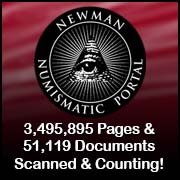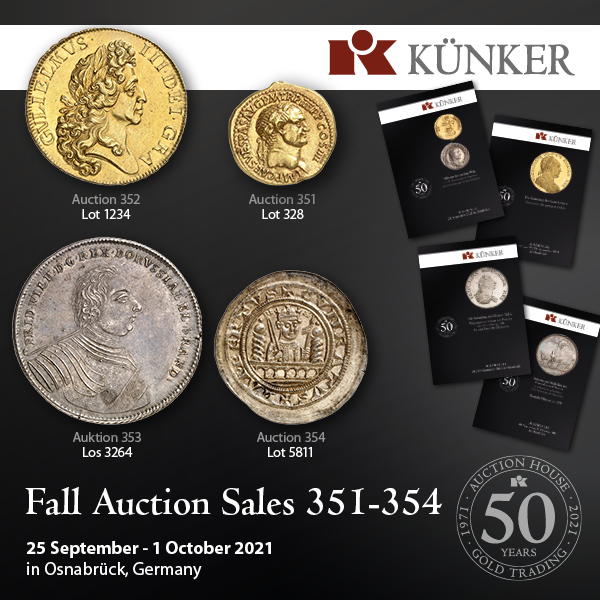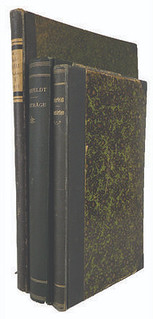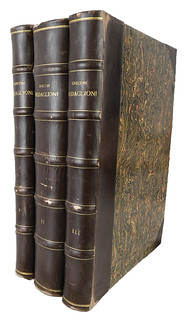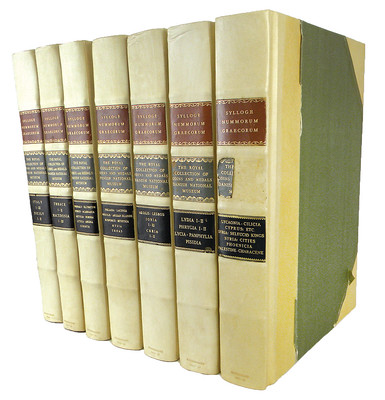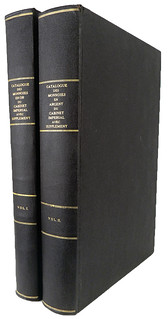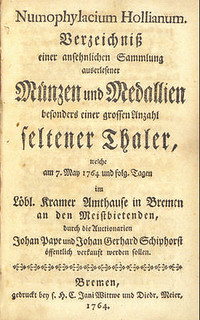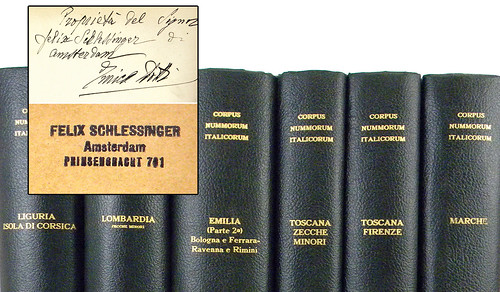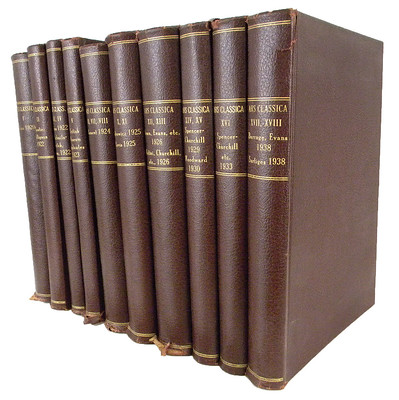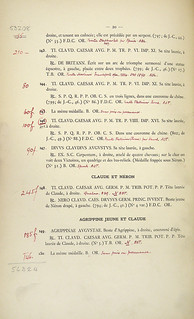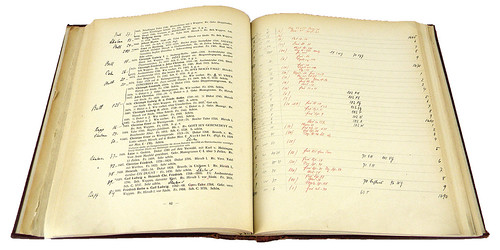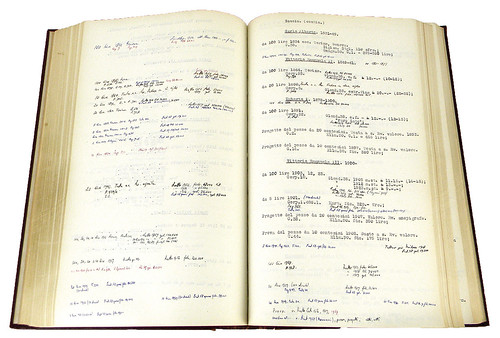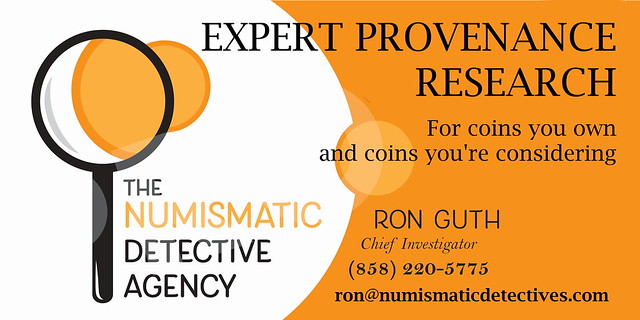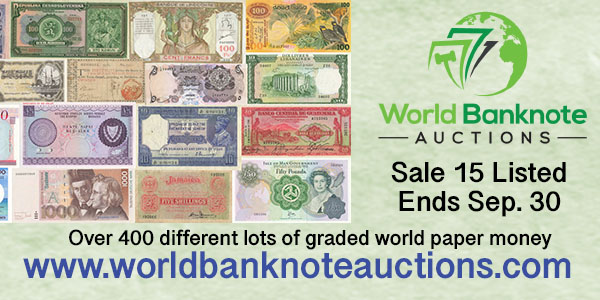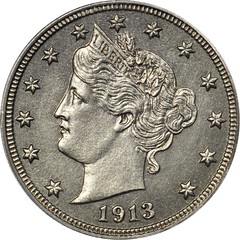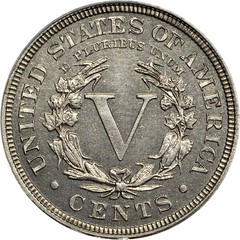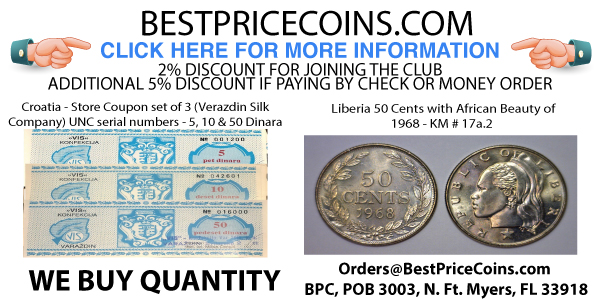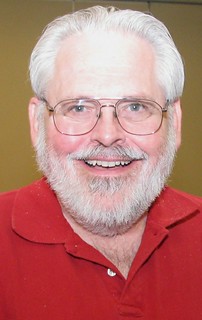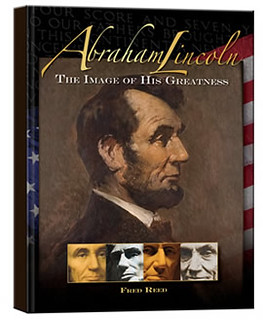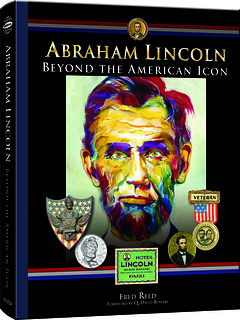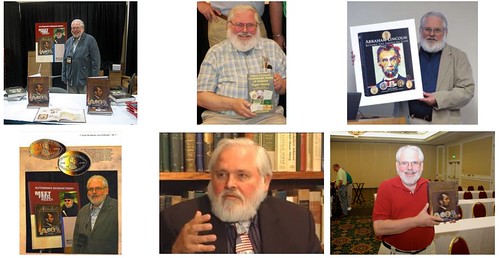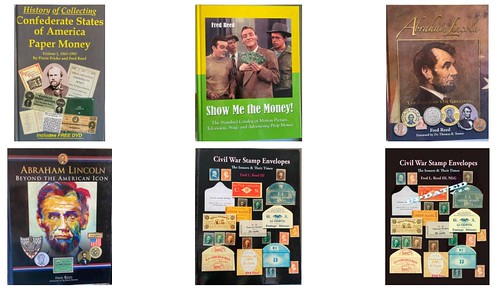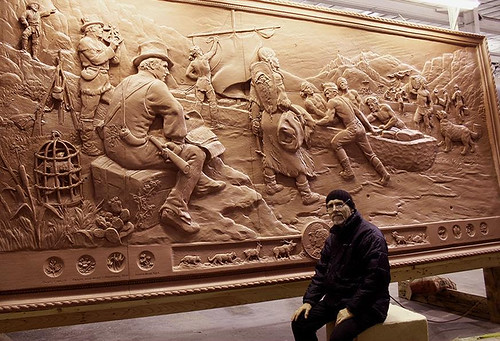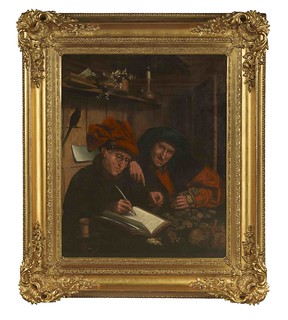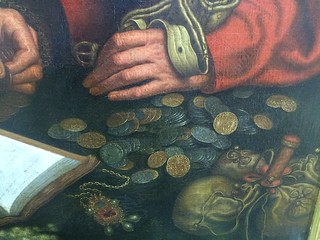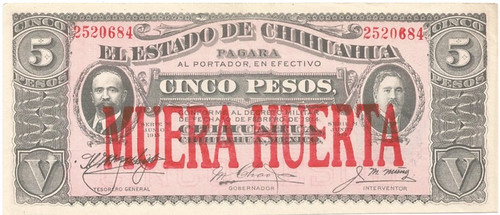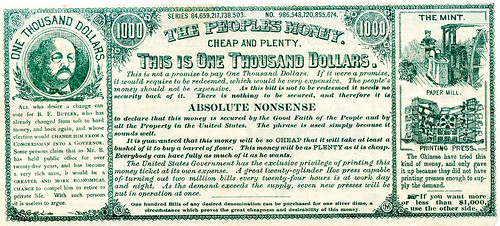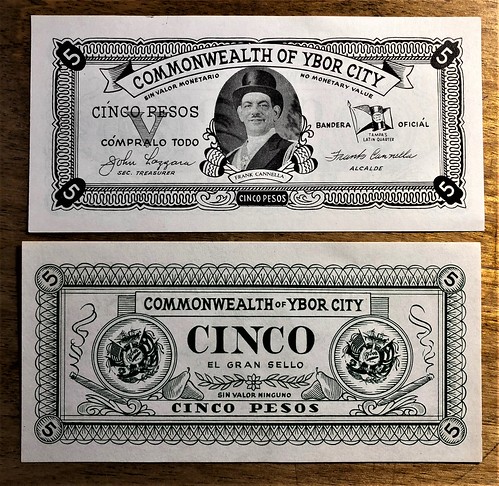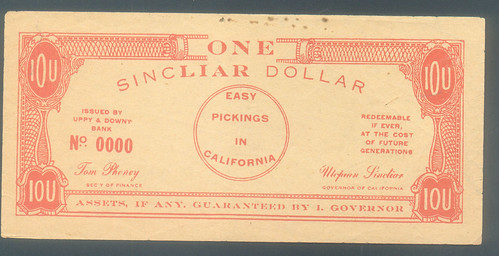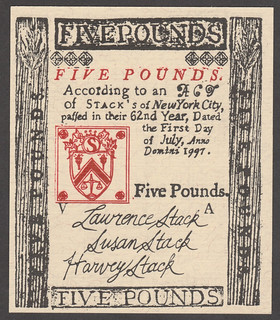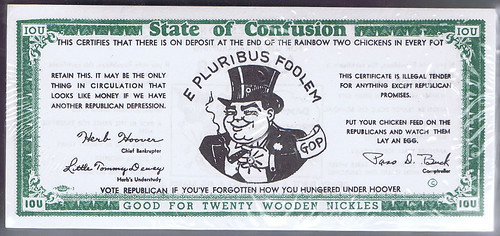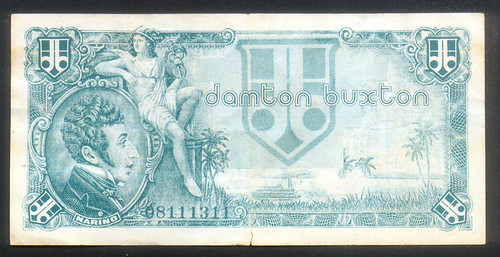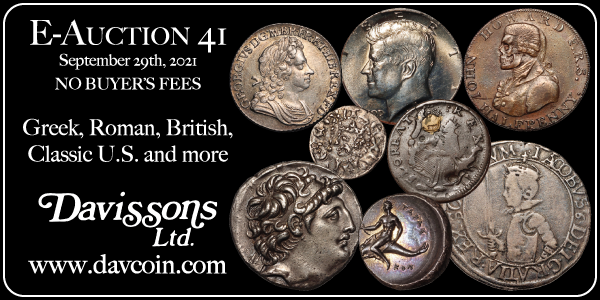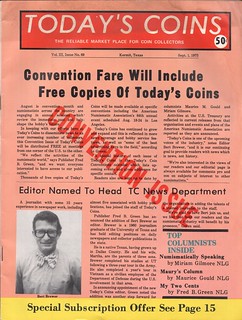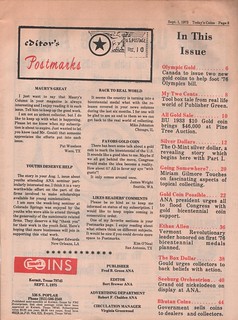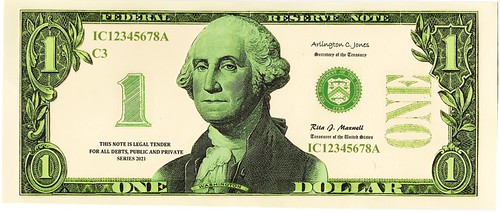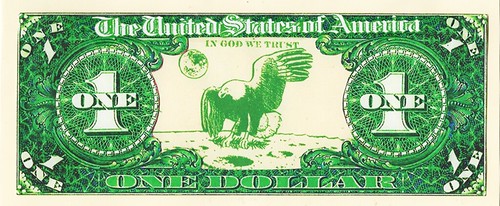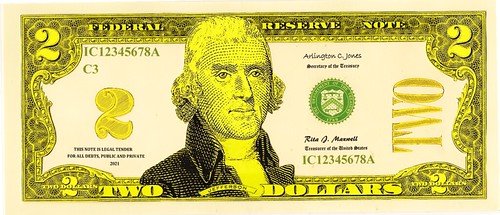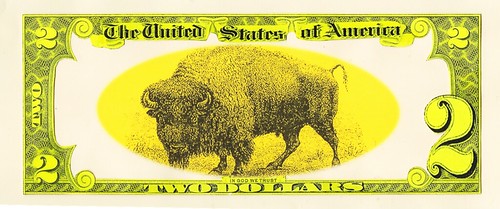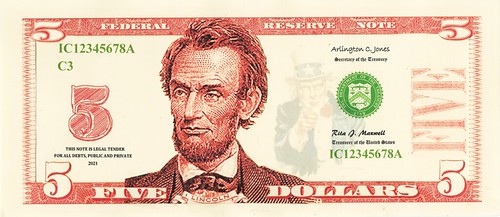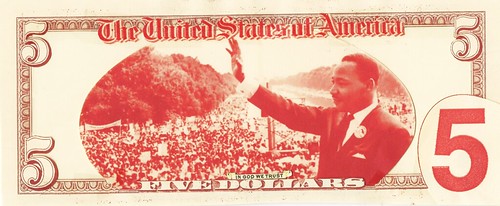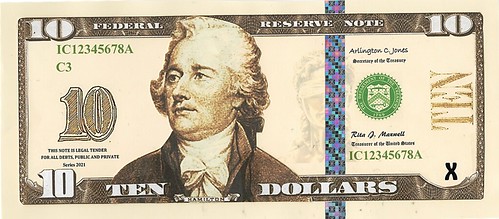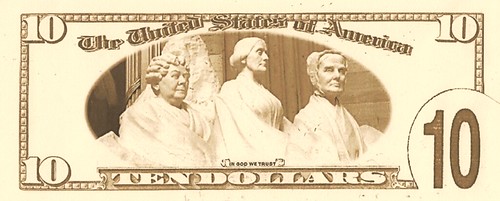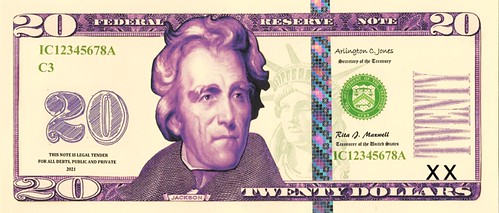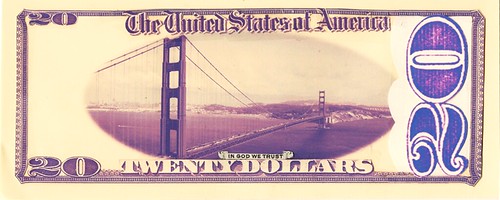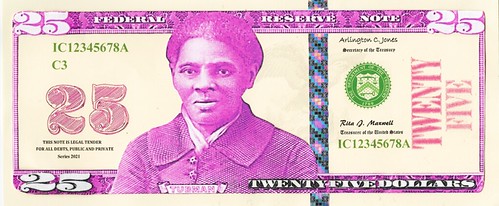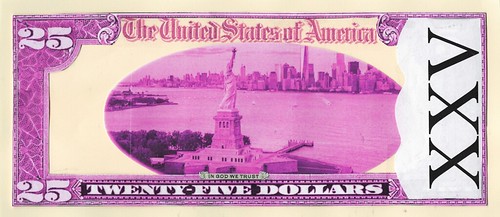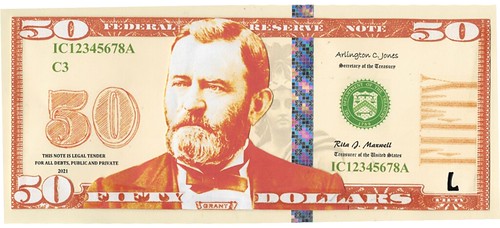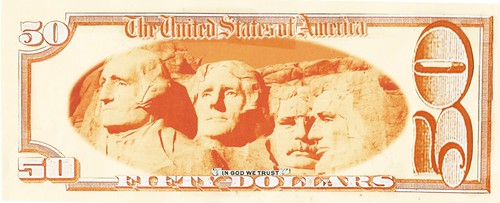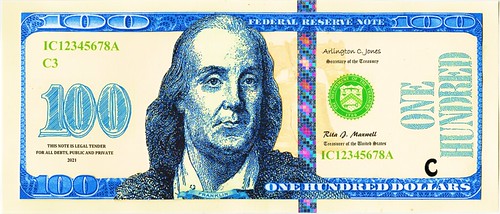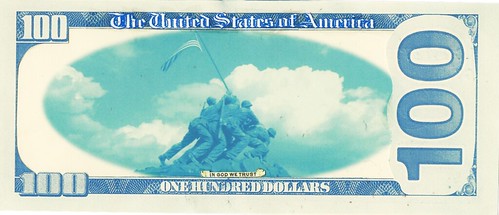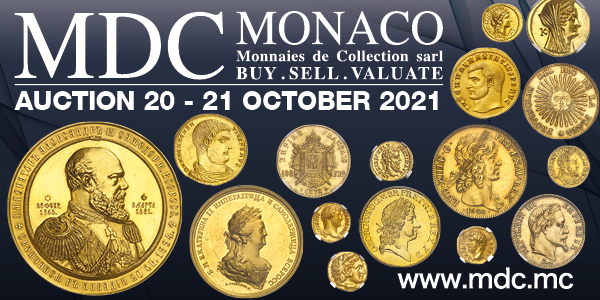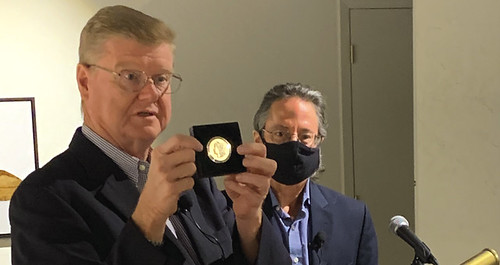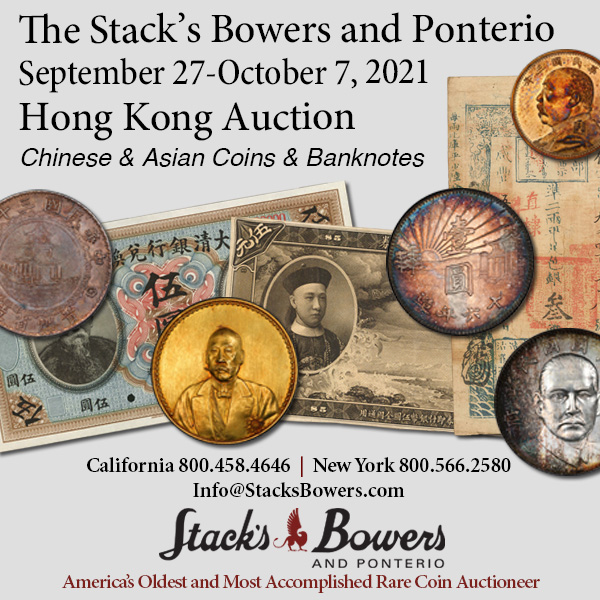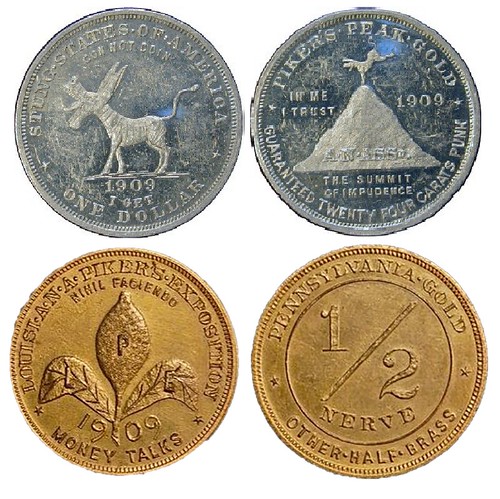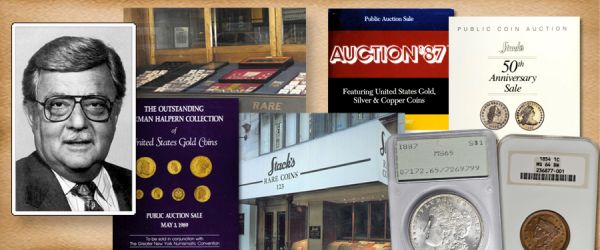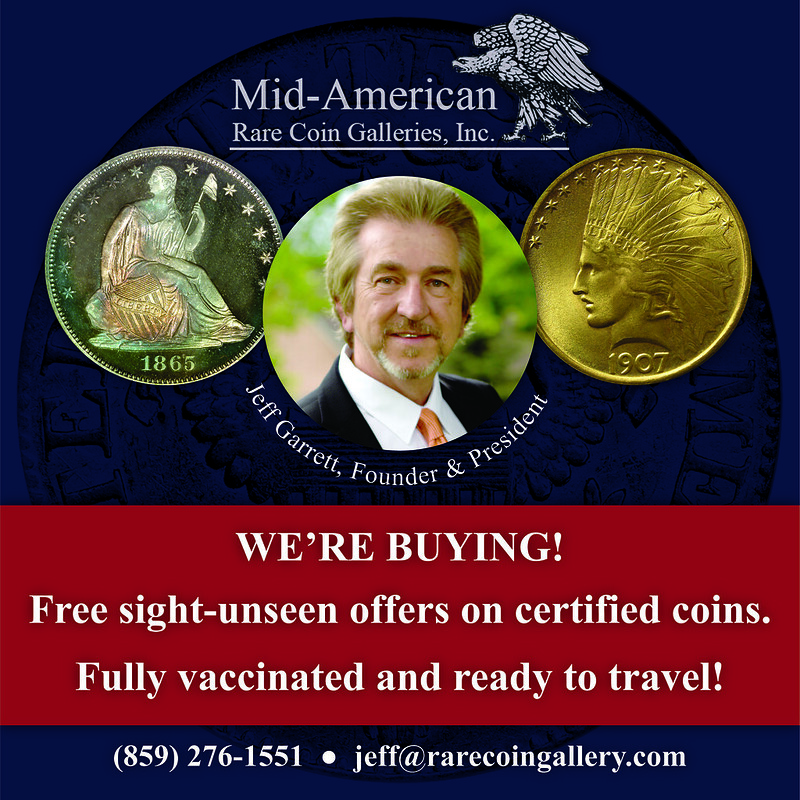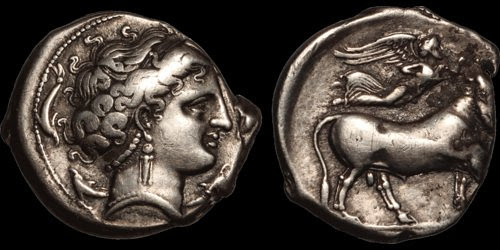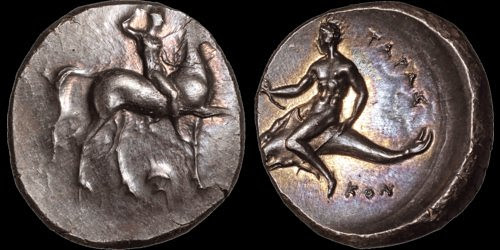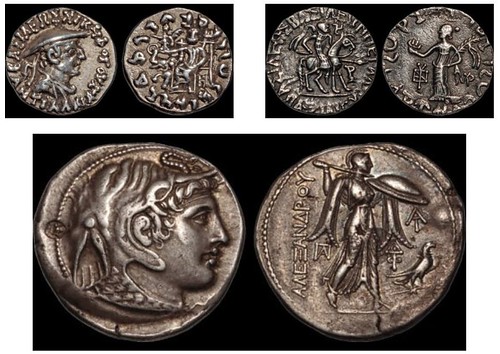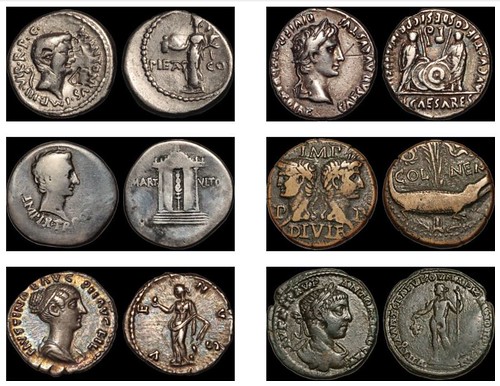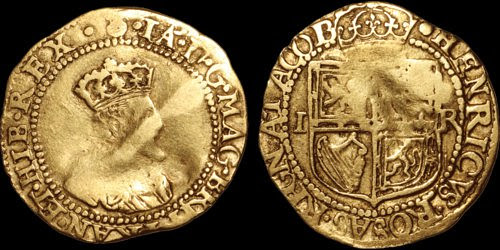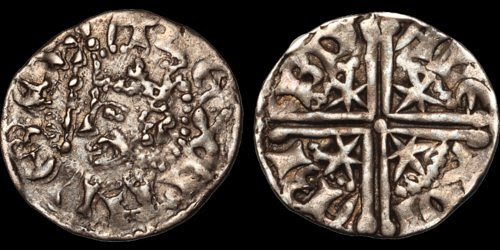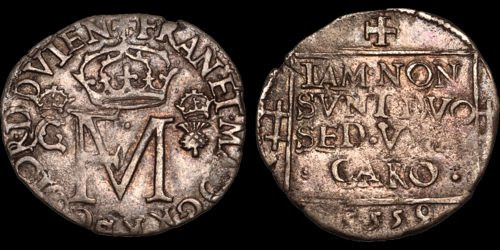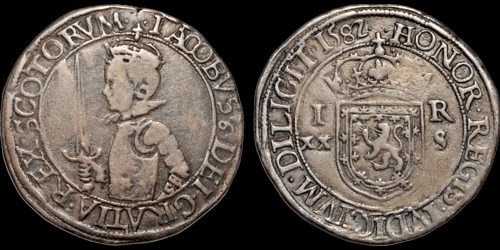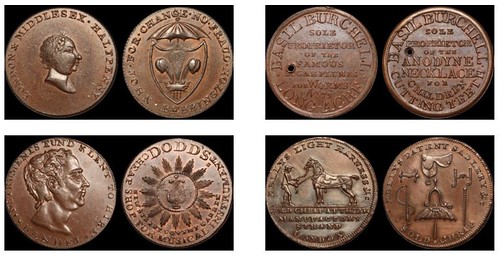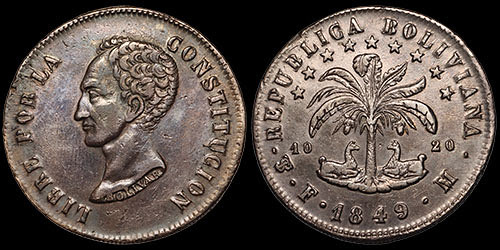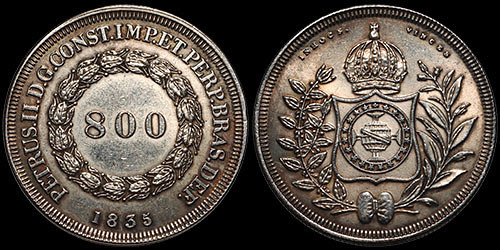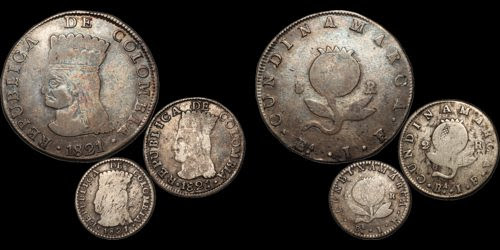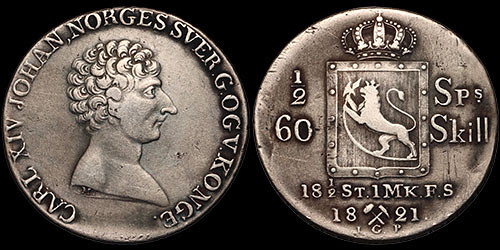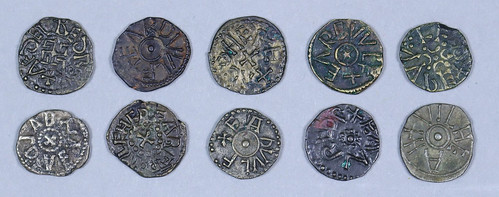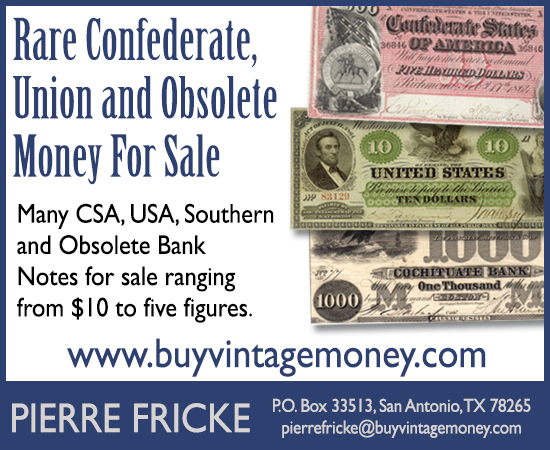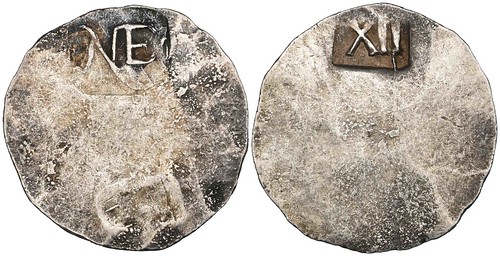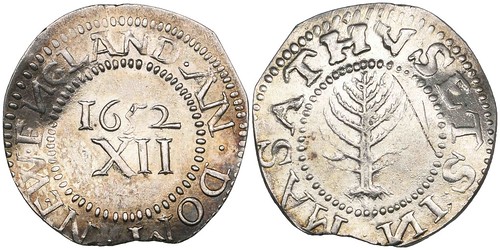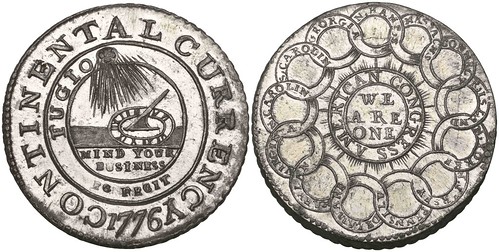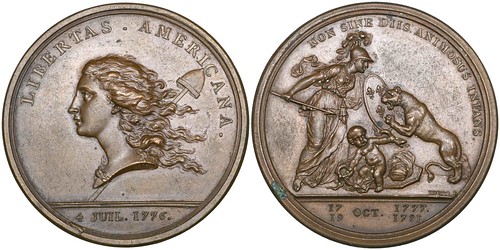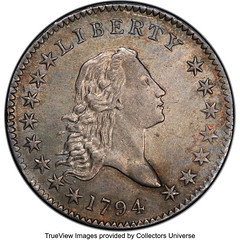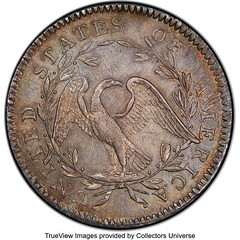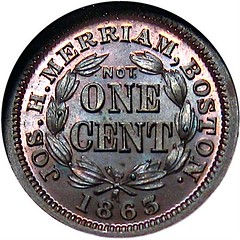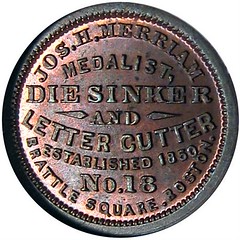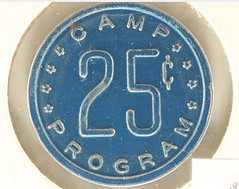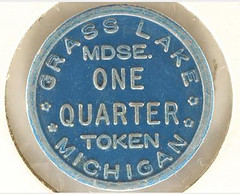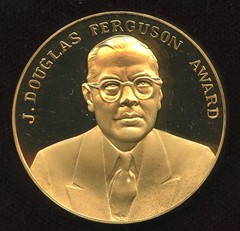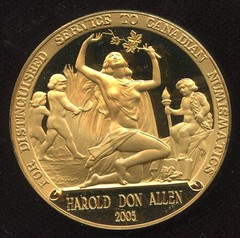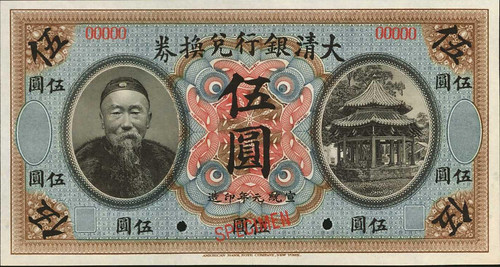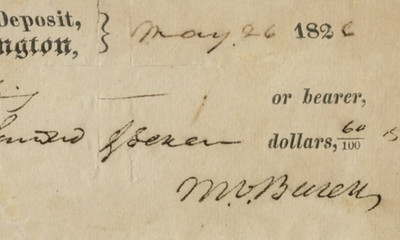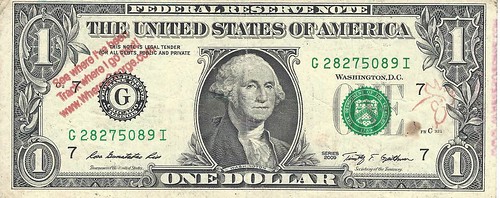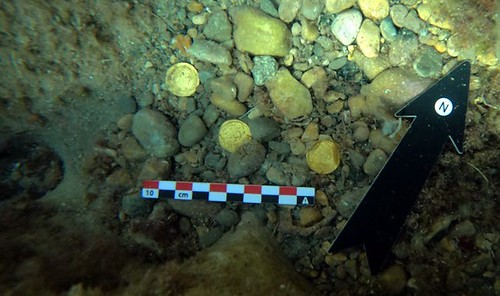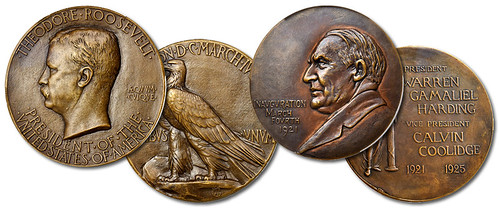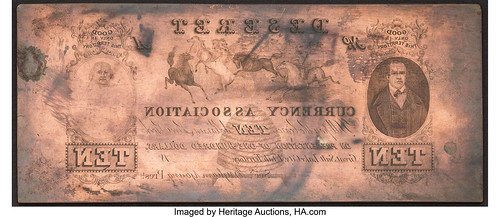
Visit our NBS Sponsors


About UsThe Numismatic Bibliomania Society is a non-profit association devoted to the study and enjoyment of numismatic literature. For more information please see our web site at coinbooks.org SubscriptionsThose wishing to become new E-Sylum subscribers (or wishing to Unsubscribe) can go to the following web page link MembershipThere is a membership application available on the web site Membership Application To join, print the application and return it with your check to the address printed on the application. Print/Digital membership is $40 to addresses in the U.S., and $60 elsewhere. A digital-only membership is available for $25. For those without web access, write to: Charles Heck, Treasurer AsylumFor Asylum mailing address changes and other membership questions, contact Chuck at this email address: treasurer@coinbooks.org SubmissionsTo submit items for publication in The E-Sylum, write to the Editor at this address: whomren@gmail.com BUY THE BOOK BEFORE THE COIN |
- WAYNE'S WORDS: THE E-SYLUM SEPTEMBER 26, 2021
- SALTON LIBRARY BRINGS RECORD PRICES
- NEW BOOK: 2022 CANADIAN COLLECTOR COINS
- NEW BOOK: MINT ERRORS TO DIE FOR, 2ND EDITION
- NEW BOOK: MUGHAL NUMISMATICS
- NEW SPANISH ONLINE RESOURCE: IMPERATRIX
- M. VERNON SHELDON ON THE 1913 LIBERTY NICKEL
- VIDEOS: FRED L. REED III
- MORE ON FRED L. REED III
- EUGENE DAUB RETROSPECTIVE
- REYMERSWAELE'S "TWO TAX COLLECTORS"
- NOTES FROM E-SYLUM READERS: SEPTEMBER 26, 2021
- PERIODICAL: TODAY'S COINS
- PEARSON: MORE DESIGNS FOR U.S. PAPER MONEY
- NEVADA MUSEUM RECEIVES 2021-CC DOLLAR
- DAVID RYDER RESIGNS AS MINT DIRECTOR
- ZERBE NAME REMOVED FROM ANA TOP AWARD
- ABOUT FARRAN ZERBE
- ANA SEEKS DONATIONS FOR INTERACTIVE EXHIBITS
- VOCABULARY TERM: FLATTENED RELIEF
- THE GRAND AND GREAT LADIES OF THE ANA
- HARVEY STACK'S NUMISMATIC FAMILY, PART 105
- DAVISSON E-AUCTION 41 HIGHLIGHTS
- JOHN CROSS COLLECTION OF ANGLO-SAXON COINS
- MORTON & EDEN OFFER SWEET TIN FIND
- NUMISMATIC NUGGETS: SEPTEMBER 26, 2021
- WAYNE'S NUMISMATIC DIARY: SEPTEMBER 26, 2021
- ROMAN GOLD COIN FIND NEAR SPAIN
- ROOSEVELT AND HARDING INAUGURAL MEDALS
- $10 DESERET CURRENCY PLATE OFFERED
Click here to read the thin version on the web
Click here to subscribe
Click here to access the complete archive
To comment or submit articles, reply to whomren@gmail.com
Content presented in The E-Sylum is not necessarily researched or independently fact-checked, and views expressed do not necessarily represent those of the Numismatic Bibliomania Society.
WAYNE'S WORDS: THE E-SYLUM SEPTEMBER 26, 2021
 New subscribers this week include:
Joe Cronin,
Rodney Merchant,
Mitresh Singh, and
Andrew Yates.
Welcome aboard! We now have 6,729 subscribers.
New subscribers this week include:
Joe Cronin,
Rodney Merchant,
Mitresh Singh, and
Andrew Yates.
Welcome aboard! We now have 6,729 subscribers.
Thank you for reading The E-Sylum. If you enjoy it, please send me the email addresses of friends you think may enjoy it as well and I'll send them a subscription. Contact me at whomren@gmail.com anytime regarding your subscription, or questions, comments or suggestions about our content.
This week we open with Salton library prices realized, three new books and a new online resource, updates from the Newman Numismatic Portal, a Eugene Daub retrospective, and more.
Other topics this week include Today's Coins, the 1913 Liberty Nickel, Fred Reed, Farran Zerbe, David Ryder, the Great Ladies of the ANA, flattened relief, auction previews, a Roman gold coin find, and inaugural medals.
To learn more about Corpus Nummorum Italicorum, mint errors, Mughal numismatics, the Two Tax Collectors, satirical banknotes, rilievo schiacciato, the Tubman $25 bill, the Empire of Brazil, the John Cross Collection, the gold Thrymsa, and the New England Shilling found in a candy box, read on. Have a great week, everyone!
Wayne Homren
Editor, The E-Sylum
SALTON LIBRARY BRINGS RECORD PRICES
Here's a report on prices realized in the recent Kolbe & Fanning sale of the Salton library. Wow! -Editor
Kolbe & Fanning Numismatic Booksellers, in cooperation with Fritz Rudolf Künker, sold the numismatic library of Mark and Lottie Salton on Saturday, September 18. The sale received widespread attention from bidders around the world, and brought exceptional results, with over 95% of the lots selling.
Some highlights of the sale included:
Lot 7: Max Bahrfeldt's Nachträge und Berichtigungen zur Münzkunde der römischen Republik, one of the key publications on Roman Republican coins, brought $4500 hammer
Lot 51: Francesco Gnecchi's magnificent three-volume I Medaglioni romani (1912), an extraordinary work on Roman medallions, sold for $9500
Lot 124: an exceptional set of the original editions of the SNG Copenhagen, complete in 43 fascicles, realized $10,000
Lot 147: both volumes of the magnificent 1759–1770 folio catalogues of the Vienna cabinet, prepared for Empress Maria Theresa, with both supplements, brought $14,000
Lot 233: an original set of the Corpus Nummorum Italicorum, the massive 20-volume compendium spearheaded by King Victor Emmanuel III, sold for $6000
Lot 284: a complete set of the Ars Classica auction catalogues of ancient coins, published between 1921 and 1938 by Jacob Hirsch, realized $6500
Lot 287: a bound volume of six extremely rare 18th-century German coin auctions sold for $7000 after very strong bidding
Lot 400: an annotated copy of the 1896 Rollin & Feuardent catalogue of the Montagu collection of Roman & Byzantine gold coins, with 41 splendid plates, brought $6000
Lot 424: the original bidbooks for the auctions held by Felix Schlessinger (Mark Salton's father) between 1928 and 1937, realized $30,000
Lot 457: Felix Schlessinger's bound volumes of coin auction records, continued by his son, Mark Salton, with tens of thousands of entries, sold for $35,000. This was the final lot of the sale and in many ways represented the apotheosis of the library.
The above prices do not include the 20% buyer premium. In all, the sale brought $381,520 hammer against an estimate of $176,280. This extraordinary result is a testament to the esteem in which the Saltons are held by the numismatic community and reflects the quality and rarity of much of their library. The successful bidders are from fourteen different countries, attesting to the library's widespread appeal.
We are grateful for the active participation of our customers and look forward to serving them in the future. Please check numislit.com to stay abreast of our activities and to browse our retail stock of numismatic books. The Salton Library's online catalogue (as well as previous auctions) can be browsed at bid.numislit.com/auctions/past
To read the earlier E-Sylum articles, see:
KOLBE & FANNING SALTON LIBRARY SALE
(https://www.coinbooks.org/v24/esylum_v24n35a02.html)
KOLBE & FANNING SALTON SALE HIGHLIGHTS
(https://www.coinbooks.org/v24/esylum_v24n36a02.html)
MORE KOLBE & FANNING SALTON SALE HIGHLIGHTS
(https://www.coinbooks.org/v24/esylum_v24n37a03.html)
NEW BOOK: 2022 CANADIAN COLLECTOR COINS
A new edition of the book on modern Royal Canadian Mint collector issues has been published. -Editor
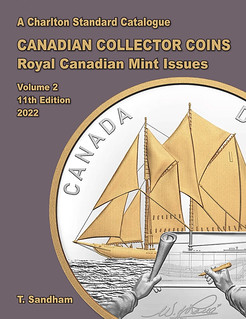 CHARLTON 2022 CANADIAN COLLECTOR COINS, ROYAL CANADIAN MINT ISSUES
CHARLTON 2022 CANADIAN COLLECTOR COINS, ROYAL CANADIAN MINT ISSUES
$46.95
VOLUME TWO, 11TH EDITION, 2022 – available in English and French
Todd Sandham, Editor
640 pages
ISBN: 978-0-88968-429-4 (ENGLISH) – 978-0-88968-430-0 (FRENCH)
The 11th edition, Volume Two is the leading authoritative catalogue on the Royal Canadian Mint collector issues on the market today. Our catalogue references virtually all of the non-circulating legal tender issues ever released by the Royal Canadian Mint since the 1950s!
This issue lists all original issue prices, current trend values, specifications, designers' and engravers' information. The 2022 edition features more than 2,200 coin designs and contains 3,000+ colour illustrations, covering all Royal Canadian Mint releases from 1954 to 2021. The 11th Edition is a must for the collector tracking mint and bullion issues and is available in Canada and the United States.
For more information, or to order, see:
CHARLTON 2022 CANADIAN COLLECTOR COINS, ROYAL CANADIAN MINT ISSUES
(https://coinstampsupplies.com/product/charlton-2022-canadian-collector-coins-royal-canadian-mint-issues/)
NEW BOOK: MINT ERRORS TO DIE FOR, 2ND EDITION
Author Joe Cronin passed along this information about the second edition of his book on error coins. Thanks. -Editor
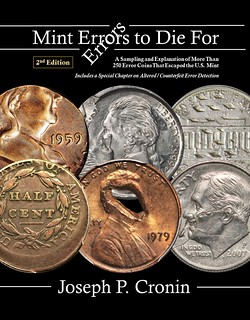 This fascinating and much-needed numismatic resource, now in its 2nd edition, is a large, 340+ page coffee-table book (8.5 by 11 inches) loaded with big HD color photos. It is written in plain language and is great for beginners, yet is extensive and detailed enough for the advanced collector.
This fascinating and much-needed numismatic resource, now in its 2nd edition, is a large, 340+ page coffee-table book (8.5 by 11 inches) loaded with big HD color photos. It is written in plain language and is great for beginners, yet is extensive and detailed enough for the advanced collector.
Learn about dozens of error types, error vocabulary, how errors occur, how to assess values, tips for error collecting, and there is even a special chapter on how to tell if a coin is damaged, altered, or counterfeit and merely appears as a genuine Mint error.
This book is a great investment to help you avoid buying all the junk out there posing as real errors, and can also help you cherry-pick a great error a seller didn't catch. Save time, money, and aggravation as you acquire errors for your collection or for sale. Get your copy today!
All copies will be signed and/or personalized by me upon request.
The book's price is $80 which includes taxes and shipping to anywhere in the U.S. Accepted forms of payment include Venmo, Zelle, and Paypal (must use "friends and family" option to avoid another $8 charge to cover fees). Under certain circumstances I can also take a personal check. Email me direct at josephcronin@protonmail.com for ordering inquiries.
NEW BOOK: MUGHAL NUMISMATICS
 Mitresh Singh of India writes:
Mitresh Singh of India writes:
"I have recently authored my maiden book on Mughal Numismatics subtitled "Revisiting Rarities: New Perspectives & Fresh Approach". The book is published by the Indian Coin Society (ICS), a registered non-profit, and was released recently on 28 Aug 2021."
Here's an excerpt from the announcement on Facebook. Follow the link below for more information. -Editor
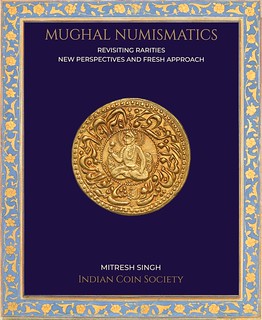 The book has been printed and financed under the Prem Ratan Maru Fellowship of Marudhar Arts and this is the first book under such scholarship. The printing quality of the book is excellent with clear high resolution images and crisp text.
The book has been printed and financed under the Prem Ratan Maru Fellowship of Marudhar Arts and this is the first book under such scholarship. The printing quality of the book is excellent with clear high resolution images and crisp text.
The books USP / salient features is as below:
- Length: 280mm / 28cm / 11 inch
- Breadth: 216mm/ 21.6cm / 8.50 inch
- Thickness: 10mm / 1 cm / 0.4 inch
- No. of pages: 226 (cover to cover)
- Edition: Paperback with thick front & back cover
The book is std A4 size length; contains 200+ color pics & illustrations; permissions from 15 International Museums (British Museum, Ashmolean Oxford UK, Bode Berlin, KHM Vienna, BNF Paris, ANS New York, Smithsonian USA, Harvard Arts, Cleveland etc) & 15 local and international auctioneers to use coin images, paintings and other art objects illustrated in the book.
The Bibliography lists more than 200+ primary, secondary and tertiary sources consulted by the author for research. All major works dealing with Mughal history is available for collectors under one book for future reference and/or further research.
Expert review notes by Jan Lingen (Moderator South Asia Coin's - Zeno.ru & Author of Jodhpur state coins) & John Deyell (ex-Canadian diplomat & Author of ‘Living without Silver' coin's of early medieval North India) based on sample review of few Chapters, with Editorial preface by Dr Prashant Kulkarni & Ashok Singh Thakur, Chairman & Secretary of ICS respectively.
The Book provides a detailed Table of all Mughal rulers who issued coins, with their reign dates in AH & CE listed, as well as an introduction to the Mughal currency, revenue, administration and military system. The contribution of the Mughals to the composite Indian culture is also highlighted viz architecture, language, dress, cuisine etc.
It explains the process by which Gigantic coin's were struck & provides a list, as well as coin images, of all known gigantic coin's. This is the first time the detailed manufacturing/striking technique of gigantic coin's has been mentioned in any text.
The origin of Nur Afshan
nisar coin's is explained as also probable rationale behind Khair Qabool
nisar coin's. This is the first time such facts have been brought to public notice.
The symbolism behind Portrait coin's as well as Jahangir's rebellion as Prince Salim is outlined. Several misconceptions are placed to rest. The Mughal Emperors role of dispensing justice is explained. The symbolism behind the sun, throne, hand on book/railing, ball/globe in hand, wine & wine cup seen on Portrait coin's is dealt in detail. This is the first time such facts are brought in print.
The chapter on Zodiac coin's outlines the basis and rationale that inspired Jahangir to strike these remarkable coin's. The scarcity of Aquarius Zodiac Mohur is explained, a topic untouched by both R.B. Whitehead and S.H. Hodivala. No other text, incl Jahangir's own autobiography, explains the inspiration or motivation that led Jahangir to strike Zodiac coin's. This is the first time such an analysis is published in any book.
For more information, or to order, see:
https://www.facebook.com/mitresh.singh.1/posts/2948351495417499
NEW SPANISH ONLINE RESOURCE: IMPERATRIX
Robert Hoge writes:
"The Spanish Numismatic Association (the redoubtable ANE -- Asociación Numismática Española -- headquartered in Barcelona) has recently launched under its auspices, with the support of the well-known firm of Aureo & Calicó, an on-line catalogue of all the Medieval coins of the Kingdom of Castile and Leon, based upon the three-volume encyclopedia compiled by Manuel Mozo Monroy. It is called Imperatrix."
Thank you! Here is the English version of the work's introduction. -Editor
The Imperatrix catalog is a literal excerpt from the numismatic catalog contained in Manuel Mozo Monroy´s book entitled Enciclopedia de la Moneda Medieval Románica, ss. VIII-XIV, volumes I, II and III (Encyclopedia of the Romanesque medieval coinage in the kingdoms of León and Castilla, 8th to 14th centuries). Thanks to the author, Imperatrix came into being to serve as a useful tool in order to easily identify and classify any Christian medieval coins from the kingdoms of León and Castilla between the VIII and XIVth centuries. Researchers, institutions, archaeologists and private collectors will benefit from public access to this catalog. It is presented with the main objective of enriching the scientific outlook on Medieval Numismatics.
This online catalog dates from the first kingdoms, contents which has already been included in the first edition of the Encyclopedia (2017), including addendums with extensions and modifications of coins from the years after publication up to the present.
The completed online catalog dates from Pedro I up to the coining of Princess Isabel and thus chronologically closing the catalog of Christian Medieval Ages of both kingdoms. Therefore, Imperatrix exclusively contains the cataloging part of Manuel Mozo Monroy´s work already mentioned, which will remain the reference for those who wish to have a deeper knowledge of Medieval Numismatics in the history of the kingdoms of León and Castilla.
Due to the evolutionary nature of the investigations, this catalog will be periodically reviewed and updated in order to include new types and numismatic variations discovered or those which have appeared in auctions. From a methodological point of view, future cataloging works will be subjected to a constant process of historiographic and hermeneutic review of sources and bibliography, in order to include coins from archeological discoveries or new coins that may appear, such as from private collections, museum specimens, or coins auctioned by numismatic trademarks.
These revisions will be under the direction of Dr. Ana Serrano PhD in History of Art, specialized in Methodologies of historiographic research
, a highly experienced professional with extensive experience in numismatic cataloging and management systems for historical heritage such as DOMUS and SIPHA.
The web version of IMPERATRIX is therefore a joint work due to the effort and knowledge of Manuel Mozo Monroy and Ana Serrano Hernández.
To visit the Imperatrix website, see:
https://wearenumismatics.com/imperatrix/
M. VERNON SHELDON ON THE 1913 LIBERTY NICKEL
The latest additions to the Newman Numismatic Portal include Eric Newman's notes on the 1913 Liberty nickel. Project Coordinator Len Augsburger provided the following report. Thanks. -Editor
M. Vernon Sheldon on the 1913 Liberty Nickel
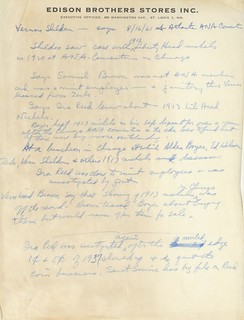 Few collectors have time during a busy coin convention to take notes on the recollections of the day. Dealers have even less, and most are just happy to keep their accounting and inventory records up to date with the day's trading. Eric Newman was an exception, recording his recollections of a discussion with Vernon Sheldon at the 1961 ANA convention in Atlanta. To set the scene, this memo was written the evening before Newman delivered one of the most anticipated speeches in ANA convention history, on a completely unrelated subject – the 1804 dollar. Newman and Ken Bressett's work was groundbreaking, and much of what is considered common knowledge today was first revealed during this presentation. But Newman was ever in information collecting mode, as demonstrated by his notes from the Sheldon conversation.
Few collectors have time during a busy coin convention to take notes on the recollections of the day. Dealers have even less, and most are just happy to keep their accounting and inventory records up to date with the day's trading. Eric Newman was an exception, recording his recollections of a discussion with Vernon Sheldon at the 1961 ANA convention in Atlanta. To set the scene, this memo was written the evening before Newman delivered one of the most anticipated speeches in ANA convention history, on a completely unrelated subject – the 1804 dollar. Newman and Ken Bressett's work was groundbreaking, and much of what is considered common knowledge today was first revealed during this presentation. But Newman was ever in information collecting mode, as demonstrated by his notes from the Sheldon conversation.
M. Vernon Sheldon (1901-1982) served as general secretary of the ANA form 1938-1944, and as president from 1949-1951. The first Farran Zerbe award, in 1951, went to Sheldon. His wife, Marcella Beck, had been a secretary to ANA president (1945-1947) V. Leon Belt. Newman spoke with Sheldon on August 16, 1961 and later wrote the following, in part:
Sheldon saw case with 1913 Liberty Head nickels in 1920 at A.N.A. Convention in Chicago. Says Samuel Brown was not ANA member and was a mint employee – a janitor, this Vernon learned from Zerbe…[Alden Scott] Boyer [Chicago Coin Club founder and ANA general secretary] kept 1913 nickels in his safe deposit for over a year after the Chicago ANA convention & the ads [soliciting 1913 Liberty nickels] were to find out if there were any more outstanding… Vernon heard Brown say that showing of 1913 nickels in Chicago was off the record. Brown teased Boyer about buying them but would never offer them for sale.
The Sheldon account must of course be corroborated with other facts. A profile in The Numismatist (October 1938), for instance, indicates he did not start collecting until 1924.
Newman's memoranda on the 1913 Liberty nickels include other tidbits, such as Newman's discussion with Samuel Brown's daughter in 1962. While Newman never uncovered the precise details surrounding their origins, his records add additional color to this most famous of American numismatic issues.
Link to Eric Newman memoranda on the 1913 Liberty nickel:
https://archive.org/details/epn8921-rf61-1913nickelmemoranda/page/n7/mode/2up
VIDEOS: FRED L. REED III
These are selections from the David Lisot Video Library that feature news and personalities from the world of coin collecting. David has been attending coin conventions since 1972 and began videotaping in 1985. The Newman Numismatic Portal now lists all David's videos on their website at:
https://nnp.wustl.edu/library/multimediadetail/522852
"Here are two videos on the Portal that feature Fred. He was a consummate researcher and great speaker. He will be missed."
Thanks! -Editor
Abraham Lincoln: The Image of His Greatness
Speaker: Fred Reed.
David Lisot Video Library (2010)
Fred is a dedicated numismatic researcher and award-winning author. Hear from the author about his book of the same title. The publication offers a behind-the-scenes look at hundreds of medals, tokens, scrip and paper money notes, world coins and more in an engaging illustrated presentation rich with numismatic imagery about America's 16th president.
https://nnp.wustl.edu/library/book/548761
Abraham Lincoln: Beyond the American Icon
David Lisot Video Library (2013)
Fred Reed speaks at the ANA World's Fair of Money in Chicago (August, 2013).
https://nnp.wustl.edu/library/book/554644
To read the earlier E-Sylum articles, see:
NEW BOOK: ABRAHAM LINCOLN: THE IMAGE OF HIS GREATNESS BY FRED REED
(https://www.coinbooks.org/esylum_v11n40a06.html)
NEW BOOK: ABRAHAM LINCOLN: BEYOND THE AMERICAN ICON
(https://www.coinbooks.org/esylum_v15n43a05.html)
FRED L. REED III (1948-2021)
(https://www.coinbooks.org/v24/esylum_v24n38a04.html)
MORE ON FRED L. REED III
The family of Fred Reed has posted a memoriam online with more information and photos. I've included two here - Fred in 2018 in an Abe Lincoln T-shirt, and another with his daughter Becky at a coin event. Thanks to Len Augsburger for passing the link along from the Central States Facebook group. -Editor
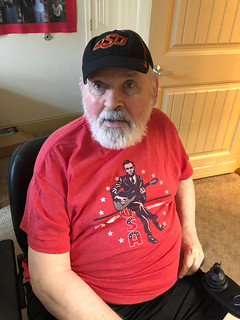 Fred Leslie Reed, III, woke walking and talking once again, swinging his arms and snapping his fingers (the way he had done when he was happy) fully restored, in Heaven on 24 July, 2021. He had lived patiently and graciously while severely disabled near his daughter's family in Dallas, TX, following a life-altering massive stroke in 2013 when he suffered this final stroke.
Fred Leslie Reed, III, woke walking and talking once again, swinging his arms and snapping his fingers (the way he had done when he was happy) fully restored, in Heaven on 24 July, 2021. He had lived patiently and graciously while severely disabled near his daughter's family in Dallas, TX, following a life-altering massive stroke in 2013 when he suffered this final stroke.
Fred was born 21 Jan, 1948, to Fred Jr. and Maria Mühlthaler in Syracuse, NY, where his grandfather, Fred Sr. was mayor and owned Reed's Bowling Alley and Reed's Esso Station. Fred's parents had met during WW2 while Fred Jr. served in the U.S. Army (England, France, and Munich). Maria had been drafted into the Nazi army but had escaped with her life after intentionally sabotaging the parachutes she was ordered to fold. The mayor of her town, Pfarrkirchen, Germany, intervened and arranged for her to clean the housing where the American soldiers were stationed, and thus began their love story. Although Fred Jr.'s family was Baptist, he deferred to Maria's Catholic background in bringing up Fred III and his younger brother, Michael.
Remembering his early years living in Syracuse with his parents and grandparents fondly, Fred revisited those beloved sites with his children and passed those stories down to his grandchildren. As a kid, he was an avid collector of baseball cards, coins and even post marks. He would go through the trash can in the post office looking for post marks from exotic cities he hadn't collected yet. He shared his father's love of the NY Yankees and Yogi Berra, playing catcher himself in Little League, as did his father before him. In his late teens, the Reeds moved to Oklahoma City where the academic brilliance he inherited from Fred Jr. shone brightly. He graduated from Putnam City High School in 1966 and dreamed of a career writing for his favorite newspaper, Coin World.
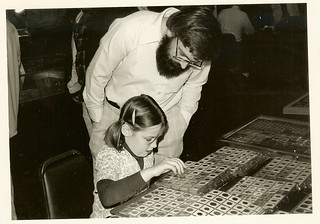 Fred married Patricia DeVaney in 1970 while the two were students at OSU, shortly after enlisting in the U.S. army. He spent 2 1/2 years stationed with the 38th Air Defense Artillery Brigade in Osan, Korea, as a photographer and journalist for the army's newspaper, The Stars and Stripes. After his honorable discharge from the army, he returned to finish his B.A. in humanities at OSU and complete his Master's Degree, bringing his toddler, Becky, along to study in the library with him and arranging for her to be the youngest person ever granted a library card of her own from the OSU library. He happily worked his dream job as an editor for Coin World in Sidney, Ohio from 1975-1980, bringing Becky along to go through the sorted mail looking for unique stamps and taking her to his monthly coin collector meetings for the frozen strawberry yogurt. He encouraged her to enter competitions with him and doted when they both won their divisions.
Fred married Patricia DeVaney in 1970 while the two were students at OSU, shortly after enlisting in the U.S. army. He spent 2 1/2 years stationed with the 38th Air Defense Artillery Brigade in Osan, Korea, as a photographer and journalist for the army's newspaper, The Stars and Stripes. After his honorable discharge from the army, he returned to finish his B.A. in humanities at OSU and complete his Master's Degree, bringing his toddler, Becky, along to study in the library with him and arranging for her to be the youngest person ever granted a library card of her own from the OSU library. He happily worked his dream job as an editor for Coin World in Sidney, Ohio from 1975-1980, bringing Becky along to go through the sorted mail looking for unique stamps and taking her to his monthly coin collector meetings for the frozen strawberry yogurt. He encouraged her to enter competitions with him and doted when they both won their divisions.
In 1980, he moved his family to Dallas, TX, to become an editor for Probe Ministries, and to write for the Ararat Report and Christian Fitness in Business. In the late 1980s, he was writer, editor, and vice-president of Beckett Publications and wrote for numerous other newspapers and magazines throughout the rest of his career. During the 80s, he dusted off his old cameras and enrolled in college photography courses for fun with his high-school age daughter, launching her into a 25-year photography career. His incredible intelligence, exacting standards, and extensive research and writing skills honed over many decades were unleashed on her from the moment that she tested "past high school" as a 6th grader, resulting in a self-driven, overachieving spelling bee winner, state competition winner, Valedictorian with two Bachelors Degrees cum laude. Fred was the greatest encouragement and influence in his daughter's life and took great pride in her accomplishments, most notably, her three children. In fact, Fred's pride in his grandfather, Fred Sr., and the mysterious void of not knowing anything about his parentage or where he came from is what ignited Rebecca's curiosity and career change into professional genetic genealogy in 2010.
Fred had always been intrigued by the stories that his namesake had changed his name and run away from home to become the larger than life figure he was to his family and community. Fred thrilled with every discovery as Rebecca pulled his family history together, especially when learning that his own ancestor, James Louis Reed (no, grandfather had NOT changed his name), had run away from home in PA to MD to lie about his age so he could fight in the Civil War like his 4 older brothers were doing. In fact, the Reed line in PA dates back to David Reed born in 1700 in Ireland. None of this would ever have been known to him or his family had it not been for his fondness for his grandfather and his sharing that plus his research skills with his daughter, Rebecca.
He was awarded a U.S. Army Commendation Medal for his journalism and "contributions to the modern volunteer Army." He was also honored by Continental Army Command, Army Times, and the joint services Defense Information School. In 2015, Fred was elected to the Society of Paper Money Collectors' Hall of Fame. The American Numismatic Association awarded him a Presidential Award (2011), First Place Literary Award (2008), and the Raymond Award for original and comprehensive research in U.S. numismatics (2008), 3 consecutive Sheehan Literary Awards for Paper Money Studies (2008-2010). The Society of Paper Money Collectors awarded him 2 Lifetime Achievement Awards for concrete/scientific contributions to the hobby (1996, 2001), 3 Awards of Merit (2000, 2006, 2012), the first Forrest Daniel Literary Award (2007), the Wismer Memorial Award for "Book of the Year" twice (2010, 2013) and 4 literary awards for articles in Paper Money. The Token & Medal Society honored Fred with its First Place Schenkman Literary Award and a special Presidential Award. The Numismatic Literary Guild has conferred 42 awards on him and the list goes on.... He has won dozens of exhibit awards at the local and national level, including the Bank Note Reporter's "Most Inspirational "Award. Fred has been a featured speaker at numismatic conventions across the country.
A journalist for more than 40 years, Fred was employed on the staffs of daily, weekly, monthly and annual publications in 5 states and the Republic of Korea. His positions have ranged from photographer, compositor, and proof reader to Editorial Director and VP of Publishing. He is the author or co-author of 16 books and editor of 9 more. He has published several thousand news/feature/research articles in periodicals. In addition to his numismatic writings, he wrote extensively on his other loves, Lincoln, the Civil War, and Christianity.
Fred will be buried with full military honors 4 Oct, 2021, at the D/FW National Cemetery at 10 a.m. Golden Gate Funeral Home. Condolences may be sent to the Taylors at PO Box 572022, Dallas, TX 75357, who will appreciate any remembrances you may wish to send or notifications of other memorials for Fred that may find. In lieu of flowers, please consider a contribution for his son-in-law, Mark, who has sustained a severe traumatic brain injury and quadriplegia: https://gofund.me/da8628b9.
To read the complete article, see:
In Memoriam
Fred Leslie Reed, III
21 Jan 1948 - 24 July 2021
(https://www.thegenealogyguru.com/in-memoriam-fred-l-reed-iii/24-july-2021-fred-woke-up-in-glory)
Another article on the site celebrates Fred as an author and lecturer. -Editor
To read the complete article, see:
FRED, THE CELEBRATED AUTHOR AND LECTURER
(https://www.thegenealogyguru.com/in-memoriam-fred-l-reed-iii/fred-the-celebrated-author-and-lecturer)
More on Fred Reed
David Thomason Alexander writes:
"I read with sorrow the notice of the death of my one-time Coin World colleague Fred L. Reed III. Wasn't it Robert Frost who penned the line "Two paths diverged in a wood..." Fred and I left Coin World one week apart. I went into cataloging for auctions, he to pursue compilation of text books for a Texas-based ministry before his eventual return to numismatic writing and research.
Fred never received adequate recognition for the work. I think of his masterful work on Massachusetts inventor John Gault and his Encased Postage Stamps of the Civil War era. When I protested the inadequacy of this book's recognition by the Numismatic Literary Guild, I was told "It sounds like just another dry book," Confessing in effect that no NLG judge even opened its cover! Dry it was NOT!"Howard A. Daniel III writes:
"Many, many years ago I met him for the first time at a Memphis International Paper Money Show. Sometime during the show we said hello to each other and started talking about our numismatic interests. We had radically different interests, to say the least. But the interesting part for me was that he collected anything about President Lincoln. It was a time when I was buying common world notes for 5 to 10 Cents each and U.S. dealer junk boxes with mostly world coins in them at $8 per pound. I would put world coins and paper money in a baggie and hand them out at my International Bank Note Society/Numismatics International club table to potential YNs.
"Some of the paper and metal objects were not ever legal tender but token and/or medallic pieces which I set aside for collectors of such things. They would go through the box of them I brought along with me. They often got very excited about a piece. One old collector went crazy about a New Jersey token I remember that came from a box I bought from a Maryland coin shop dealer. It was the missing denomination on paper that he had predicted many years prior to finding it in my box which had to exist. I knew there were also President Lincoln items in the box and I brought Fred to the table to see them. He actually found several he did not own or know about! From then on, I would immediately mail to him any President Lincoln piece I found. He was often ecstatic about what I sent him and he would send me an email to thank me.
"I was in contact with up to around 2014 or so but then he fell ill and I was no longer able to correspond with him or see him at Memphis. There have been very few numismatists like Fred but I hope I run into more like him in the future. "
To read the earlier E-Sylum article, see:
FRED L. REED III (1948-2021)
(https://www.coinbooks.org/v24/esylum_v24n38a04.html)
EUGENE DAUB RETROSPECTIVE
The work of sculptor and medal designer Eugene Daub is featured in a retrospective at the Palos Verdes Art Center. -Editor
Palos Verdes Art Center / Beverly G. Alpay Center for Arts Education has announced Eugene Daub: Monumental, a retrospective of the internationally acclaimed sculptor's large public works. This exhibition will offer a behind-the-scenes view into the creation of monumental sculptures – starting from the sketch to a maquette, the enlargement, the mold-making process, and finally the pouring of the bronze and welding it all back together again from many pieces.
Among the 12 of Daub's monumental works chronicled by this exhibition are Lewis & Clark, Kansas City, Missouri; Rosa Parks, US Capitol, Washington, D.C.; Harry Bridges, ILWU Union Hall, Wilmington, CA; Thomas Jefferson, University of Virginia, and Phineas Banning, Banning's Landing, Wilmington.
This past June, On June 19, Daub won the Marcel Jovine President's Prize for a realistic work, in the form of a bas-relief of Civil Rights leader and legendary member of Congress, John Lewis.
In 2013, a monument he completed of another Civil Rights icon, Rosa Parks, was installed in the statuary hall of the U.S. Congress. In 2019, Daub completed a bronze statue of Harry Bridges. Within the past 30 years Daub has designed and created many public art commissions for the U.S. government, private foundations, universities and corporations and has exhibited in the British Museum and the Smithsonian Institute, among other locations.
His previous commissions include Harvey Milk, young Abraham Lincoln and Thomas Jefferson. The artist has built his reputation on classically styled figurative works. His accomplishments have been recognized through numerous awards in full figure, monumental and bas relief sculpture. He serves on the board of the National Sculpture Society and has taught sculpture around the country for years.
Most recently, Daub has been creating small metal disc sculptures of San Pedro's famed poet Charles Bukowski. The sculptures are to raise funds toward creating a bust to be displayed in a location to be determined within the Waterfront Arts District. Plans have been in the works for the Bukowski in Bronze bust since August 2019 but were slighted by the pandemic.
Daub's first job in sculpture was for The Franklin Mint where he developed skills in relief sculpture. He taught at the Academy of Art University in San Francisco from 1993 to 2002. He has been an instructor at the Scottsdale Artists' School from 1991 to the present and is the designer of the first Philadelphia Liberty Medal, which that city awards every year to a champion of world peace.
Daub has exhibited extensively and has works in numerous public collections including the Helsinki Art Museum, the British Museum; the Smithsonian Institution; The National Statuary Hall Collection in the United States Capitol, and the United States National Park Service. Daub has created over 40 major monuments in the U.S. in the last 30 years and is a Fellow of the National Sculpture Society.
In the last 30 years Daub has created over 40 major monuments in the U.S. He won both of the nation's highest awards for excellence in metallic art: The Saltus Award from the American Numismatic Society, and the gold medal, from the American Numismatic Association. The exhibition runs from Sept. 25 to Nov. 13.
To read the complete article, see:
PV Art Center Announces Eugene Daub Retrospective
(https://www.randomlengthsnews.com/archives/2021/09/23/pv-art-center-announces-eugene-daub-retrospective/35841?v=7516fd43adaa)
REYMERSWAELE'S "TWO TAX COLLECTORS"
Steve Roach writes:
"You featured one of my favorite paintings! There's currently a version of it on loan at the ANA Money Museum. I've attached some photos in its current display in the lower level gallery. What's really interesting about it is how specific the artist was in depicting money (along with the great 19th century giltwood and gesso frame!). "
Who knew? Not me! Thanks so much for letting us know. Steve sent some great photos. -Editor
For an online version of the exhibit, see:
The History of Money
(https://www.money.org/money-museum/history-of-money)
To read the earlier E-Sylum article, see:
NOTES FROM E-SYLUM READERS: SEPTEMBER 19, 2021 : Numismatic Book Cover Idea
(https://www.coinbooks.org/v24/esylum_v24n38a10.html)
THE BOOK BAZARRE
NOTES FROM E-SYLUM READERS: SEPTEMBER 26, 2021
Coin World Weekly Print Edition
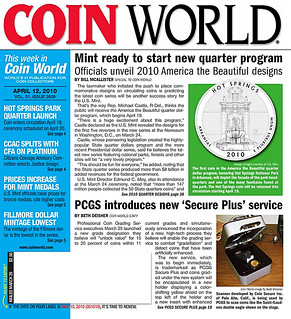 Tom Caldwell writes:
Tom Caldwell writes:
"Coin World still is indeed still a weekly. Monthly it is a more robust publication & the other weeks quite the slimmed down version. I believe subscribers can go for 12 issues annually or 52."
Tom was reacting to a comment by Tom DeLorey about the publication of Coin World in print. Those of us living in the online world can lose track of these things, but Tom C. is right - Coin World does still publish a weekly paper and ink issue. Thanks. -Editor
To read the earlier E-Sylum article, see:
NUMISMATIC SCRAPBOOK CONTRIBUTOR TOKENS
(https://www.coinbooks.org/v24/esylum_v24n37a14.html)
Thoughts on the Muera Huerta Notes
Adrián González-Salinas writes:
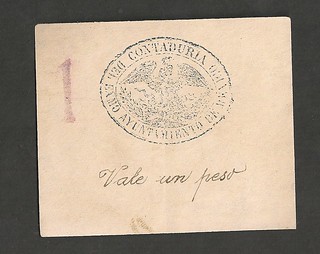 "According to"A Muera Huerta 1 Peso Note", in the obverse, at 10:45 begins the legend (against clockwise): "CONTADURIA DEL EX(CELENTISI)MO AYUNTAMIENTO DE MEXICO" (ACCOUNTANT OF THE EXCELLENT MEXICO COUNCIL). I have seen this legend in historic papers dated 1830-1860 therefore it's so rare for me to see these seals during Mexican Revolution (ater 1913) documents.
"According to"A Muera Huerta 1 Peso Note", in the obverse, at 10:45 begins the legend (against clockwise): "CONTADURIA DEL EX(CELENTISI)MO AYUNTAMIENTO DE MEXICO" (ACCOUNTANT OF THE EXCELLENT MEXICO COUNCIL). I have seen this legend in historic papers dated 1830-1860 therefore it's so rare for me to see these seals during Mexican Revolution (ater 1913) documents.
"Also, the reverse note ("bill") has the inscription Muera Huerta. In Spanish, we use an opening quotation mark () and a closing quotation mark (
) so this note has
two opening quotation marks! Frankly, it's very strange to me to see two opening quotation marks in the note!
"In summary, it's my personal point of view that both notes: the first with a "MUERA HUERTA" red overprint and the second with just a XIX century seal are just fantasies.
"Why? Well, "Muera Huerta" coins were struck in 1914 and suddenly these notes (overprint and seal notes) appeared. Both notes are not catalogued in the last +60 years. For me, it's like a Confederate States of America bill with "DEATH TO LINCOLN" overstamp appears at the present time or "DEATH TO JEFFERSON F. DAVIS" overstamp on a Union bill/note. "
Thank you. -Editor
For more information about quotation marks, see:
Quotation mark
(https://en.wikipedia.org/wiki/Quotation_mark)
To read the earlier E-Sylum articles, see:
NOTES FROM E-SYLUM READERS: AUGUST 29, 2021 : Muera Huerta Paper Money
(https://www.coinbooks.org/v24/esylum_v24n35a13.html)
NOTES FROM E-SYLUM READERS: SEPTEMBER 5, 2021 : A Muera Huerta 1 Peso Note
(https://www.coinbooks.org/v24/esylum_v24n36a08.html)
MORE ON MUERA HUERTA OVERSTAMPS
(https://www.coinbooks.org/v24/esylum_v24n37a13.html)
Correction: Numismatic Literary Guild Award Listing
Michael Kodysz writes:
"I'm the delighted winner of the NLG Best Photography category for 2021. However, I've seen the award announced in several places, including Coin World, The Numismatist, and the NLG's own website as:
"Halley's Comet – Michael A. Kodysz – ANA eLearning Academy
"The problem is, the title of the presentation I recorded for the ANA eLearning Academy in which the photos were used is called "Symbols of the Sun God on Coins of the Eccentric Emperor Elagabalus. So the title is completely wrong. It would be like winning an award for best book but the title is for another book. So a corrected award listing would read:
"Symbols of the Sun God – Michael A. Kodysz – ANA eLearning Academy"
Thanks for letting us know; happy to set the record straight. -Editor
To read the earlier E-Sylum article, see:
2021 NUMISMATIC LITERARY GUILD AWARDS
(https://www.coinbooks.org/v24/esylum_v24n33a08.html)
More on Satirical Banknotes
Regarding the satirical note published last week,
Dave Schenkman writes:
"As I recall, I brought three of those ABSOLUTE money
NOTES TO A DINNER SOME TIME BACK. One was the type pictured this week; pics of the other two are attached. I don't think any of them are especially scarce."
Indeed he did - I thought these looked familiar! He'd brought them to one of our Nummis Nova dinners in March 2018. Here's one of them; see the earlier article (linked below) for more. -Editor
To read the earlier E-Sylum article, see:
WAYNE'S NUMISMATIC DIARY: MARCH 18, 2018
(https://www.coinbooks.org/v21/esylum_v21n11a23.html)
NUMISMATIC NUGGETS: SEPTEMBER 19, 2021 : United Slaves of America Parody Note
(https://www.coinbooks.org/v24/esylum_v24n38a21.html)
James from Best Price Coins writes:
"Here are some other examples of Parody/Satirical style notes which in some way borders on Advertising & Knock-off styles (From the US & foreign countries)."
Thanks. I'd never seen the Stack's colonial advertising note before. -Editor
PERIODICAL: TODAY'S COINS
Dave Lange submitted this note on an obscure numismatic periodical. Thank you! -Editor
In researching coin folders and albums I've found that some of the best sources are the commercial numismatic publications that flourished in the 1950s-70s. I always buy old issues of COINS and COINage when I can get them at a reasonable price, since these are not yet viewable in their entirety at the Newman Numismatic Portal.
There are many lesser-known periodicals from that period, as well, and I have sine of these in my collection. One that was completely new to me when I picked it off eBay is TODAY'S COINS. The issue I have is dated September 1, 1975, and the publication statement indicates that it was produced "semi-monthly at Kermit, Texas by FBG Enterprises." The FBG is Publisher Fred B. Green, a name that means nothing to me. He applied for membership in the ANA in April, 1973, sponsored by Maurice Gould. Evidently, Green became quite active in a very short time, as the July 1973 issue placed him in a tie with Gould as the top recruiters of new members, 37 each for the month of May.
My one example of this publication states that it is Volume III, No. 69, so Green joined the ANA shortly after he produced Volume I, No. 1 in 1972 (Coin World reported that his first issue would be dated October 15 of that year).The editor of this magazine was Bert Brewer, another name unfamiliar to me. His membership application for the ANA was published in the November 1975 issue, with John Jay Pittman as sponsor, so he was evidently new to the coin field when the issue I have was published. We do know what he looked like, as his portrait photo is on the cover!
The only well known names among the contributors to this magazine are the aforementioned Gould, who had a regular column in this and other publications, and John Kamin, who is familiar as a coin investment advisor. There are quite a few major advertisers, typically the same ones who ran monthly ads in COINS and/or COINage. I checked to see whether this publication is to be found at the NNP, but there's no mention of it. We can only guess at how long it lasted after 1975.
Interesting. I'd never seen nor heard of this publication. Does anyone have more information about it or the people involved with it? Anyone have a run of these in their library? -Editor
PEARSON: MORE DESIGNS FOR U.S. PAPER MONEY
Wayne Pearson passed along these additional design ideas for U.S. paper money. Thanks. -Editor
Our paper money is, and has been, identified by the person on it since 1929. I think that is an important factor, one that allows stability. However, it makes adding a new face like Harriet Tubman difficult unless you are willing to part with a familiar face. Like coins, the faces on paper money are the incumbents and newcomers are rarely welcomed. John F. Kennedy, Susan B. Anthony and Sacagawea to name a few on the coins since 1909 when we started using people.
In this group of redesigned paper money, while the same seven faces are used, each bill has a different color, a new format, and a new design on the back. Additionally, a new denomination is added using Harriet Tubman.
Only three denominations seem possible to fit in with the current group. A half dollar note like they have in the Bahamas. A twenty-five dollar note. And a two hundred dollar note, like they have in the EU. I chose to use a twenty-five dollar denomination with Harriet Tubman. She would be the first woman used on a piece of paper money since 1929. She would also be the first black person to be used on paper money since 1929. Additionally, since 1929, we have had twelve different denominations (including the $100,000 note) on small size paper money. A new denomination would be symbolic being the thirteenth denomination.
Would a $25 design fly? Why do we have a $20 bill and a 25 cent coin, anyway? That never seemed right to me, but I think like an engineer. A new denomination might be an easier sell for a Tubman note, so no existing note has to make way for it. Only the U.S. Treasury can make these decisions, but it's always an entertaining exercise. -Editor
NEVADA MUSEUM RECEIVES 2021-CC DOLLAR
Coin World reported that the Nevada State Museum has received an example of the new 2021-CC Morgan dollar. Here's an excerpt - see the complete article online. -Editor
A privy-marked 2021-CC Morgan dollar struck at the Philadelphia Mint was formally presented Sept. 14 to the Nevada State Museum in-person by Rep. Mark E. Amodei, R-Nev. The museum is located in the former Carson City Mint building.
U.S. Mint Director David J. Ryder participated in the Sept. 14 presentation virtually via videoconferencing.
The coin presented by Amodei to the Nevada State Museum is the example he struck at the Philadelphia Mint on July 19, said U.S. Mint spokesman Michael White.
Amodei presented the coin to the museum on behalf of the Mint. The coin was not one of the first strikes, White said.
The historical significance of the Carson City Mint is an integral part of who we are,
Amodei said Sept. 14. Today, we celebrated the 100th anniversary of the last Morgan Dollar minted in the U.S. It is only fitting that the Carson City Mint played such a significant role in numismatic history and in this Commemorative Morgan Silver Dollar Coin Program.
To read the complete article, see:
Nevada museum gifted 2021-CC dollar from U.S. Mint
(https://www.coinworld.com/news/us-coins/nevada-museum-gifted-2021-cc-dollar-from-u-s-mint)
DAVID RYDER RESIGNS AS MINT DIRECTOR
The gift to the Nevada State Museum was one of David Ryder's last acts as Mint Director. In a September 24th press release, the Mint announced his resignation. -Editor
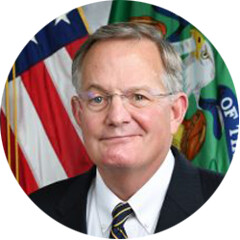 Today, the U.S. Department of the Treasury announced Alison Doone as the new Acting Director of the U.S. Mint. Doone previously served as Chief Administrative Officer at the Mint. Doone's first day as Acting Director will be on October 1 as Director David J. Ryder leaves the bureau to pursue new opportunities.
Today, the U.S. Department of the Treasury announced Alison Doone as the new Acting Director of the U.S. Mint. Doone previously served as Chief Administrative Officer at the Mint. Doone's first day as Acting Director will be on October 1 as Director David J. Ryder leaves the bureau to pursue new opportunities.
I'm excited to serve the U.S. Mint as Acting Director to help it continue its important work,
said Alison Doone. I look forward to working alongside the devoted Mint employees across the country and supporting our ongoing efforts to ensure that we are operating efficiently and producing quality products for the American people.
We thank Director Ryder for his dedicated service to the U.S. Mint and welcome Alison to serve in this role,
said Deputy Secretary Wally Adeyemo. It is essential for the U.S. Mint to continue its critical operations to produce our coinage amid increased demand and safeguard American assets. I have confidence that Alison's leadership will help us carry out this mission.
It was an honor to serve as the 34th and the 39th Director of the U.S. Mint,
said Director David J. Ryder. During this global pandemic, the U.S. Mint has showcased American excellence. Not only did the Mint meet its primary mission of producing circulating coinage, but it generated near-record revenue by introducing wildly popular numismatic products at a time in which many of its peers around the world ceased operations. Thank you to all of the employees who work tirelessly and play a role in ensuring that the Mint can meet the demands of the public, deliver quality products, and operate effectively. I know that with Alison serving as Acting Director, the Mint will continue to do just that.
Doone, a member of the Senior Executive Service since 2004, has served as the Mint's Chief Administrative Officer since March 2021.
Before beginning her work with the Mint, Ms. Doone served as the Chief Financial Officer for the Department of Education from August 2018 to March 2021; Deputy Chief Financial Officer at the Department of Energy from January 2013 to August 2018; Chief Financial Officer at the General Services Administration from September 2010 to January 2013; Chief and Deputy Chief Financial Officer at the Internal Revenue Service from August 2005 to September 2010; and, Deputy Assistant Administrator for the Drug Enforcement Administration from June 2004 to August 2005. Prior to her appointments in the SES, Ms. Doone served as a Senior Level (SL), Deputy Staff Director for Management at the Federal Election Commission from November 1999 to June 2004.
Ms. Doone holds a Bachelor of Arts degree in political science from Pennsylvania State University and a Master's degree in finance from the University of Michigan.
It's not uncommon for political appointees to move on or be forced out when another party comes into the government. Ryder was nominated for his second term as Mint Director by President Trump in 2017. Greysheet editor and publisher John Feigenbaum commented on the announcement in a September 25, 2021 Editorial. -Editor
"This announcement ends Ryder's second term in the position and I had personally found him to be a highly-visible, congenial, and a proactive advocate for collectible numismatics at the U.S. Mint during his second term. I spoke with Mr. Ryder at numerous trade shows from the ANA World's Fair of Money events to the Berlin World Money Fair in 2019. It was clear to me he was very engaged in his role and interested in delivering quality products for the public and collectors alike.
"The Mint has had its public struggles lately, mostly with the web site crashing under extreme pressure during limited releases of new collector coins. However, Mr. Ryder has been responsible for many progressive and thoughtful moves at the agency, including the 2021 commemorative silver dollar program which have seen modern interpretations of the Morgan and Peace silver dollars.
"It is often said that the U.S. Mint is the world's largest coin dealer, so this is a critical story for the numismatic community and we will continue to follow developments and try to learn the nature of Mr. Ryder's sudden departure."
To read the complete article, see:
Ryder Suddenly Out as Director of the U.S. Mint
(https://www.greysheet.com/news/story/david-ryder-out-as-director-at-the-u-s-mint)
ZERBE NAME REMOVED FROM ANA TOP AWARD
In another sudden announcement, the American Numismatic Association issued a press release this week announcing a name change for its top award. -Editor
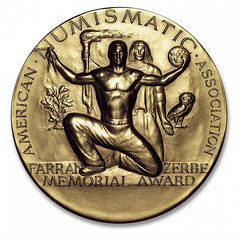 During an open session meeting on January 19, 2021, the ANA Board of Governors honored the wishes of nearly 20 past Farran Zerbe Memorial Award winners by voting to remove Zerbe's name from the ANA's highest honor after the 2021 presentation (its 70th year). According to the motion, the accolade will be called the Distinguished Service Award "until such time as the name of an exemplary, deceased ANA member be brought forward to the Board, after vetting by the Awards Committee, for consideration of formal approval with proper funding arrangements for such naming rights."
During an open session meeting on January 19, 2021, the ANA Board of Governors honored the wishes of nearly 20 past Farran Zerbe Memorial Award winners by voting to remove Zerbe's name from the ANA's highest honor after the 2021 presentation (its 70th year). According to the motion, the accolade will be called the Distinguished Service Award "until such time as the name of an exemplary, deceased ANA member be brought forward to the Board, after vetting by the Awards Committee, for consideration of formal approval with proper funding arrangements for such naming rights."
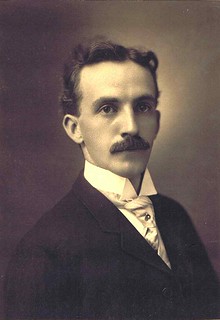 A well-known figure in 20th-century numismatics, Joseph Farran Zerbe served as ANA president from 1907-1909. A retrospective look at Zerbe's professional dealings uncovered accusations that he made deceptively inflated claims about the future value of the Louisiana Purchase Exposition gold dollars he sold; complaints of hucksterism and fraud for his creation and sale of coin-like 1904 gold-plated exposition souvenirs; allegations that he unscrupulously obtained personal ownership of The Numismatist in 1908 from relatives of the ANA's late founder, Dr. George F. Heath (then ANA Vice President W.W.C. Wilson subsequently purchased the periodical and donated it to the Association in 1910); and claims of bribery involving the 1909 ANA election in which Zerbe's friend John M. Henderson was named president.
A well-known figure in 20th-century numismatics, Joseph Farran Zerbe served as ANA president from 1907-1909. A retrospective look at Zerbe's professional dealings uncovered accusations that he made deceptively inflated claims about the future value of the Louisiana Purchase Exposition gold dollars he sold; complaints of hucksterism and fraud for his creation and sale of coin-like 1904 gold-plated exposition souvenirs; allegations that he unscrupulously obtained personal ownership of The Numismatist in 1908 from relatives of the ANA's late founder, Dr. George F. Heath (then ANA Vice President W.W.C. Wilson subsequently purchased the periodical and donated it to the Association in 1910); and claims of bribery involving the 1909 ANA election in which Zerbe's friend John M. Henderson was named president.
This action seems sudden and arbitrary with no prior discussion of the issues. I'm curious to know what led to this and what actual evidence for the decision was presented to the board. Why couldn't there have been discussions in the pages of The Numismatist? In his Coin Collectors Blog Scott Barman questions the evidence as well. -Editor
"What are the claims? Who made the claims? What documentation do we have of the claims?"
To read the complete article, see:
The ANA Woke Up on the Wrong Side, for a change
(http://coinsblog.ws/2021/09/the-ana-woke-up-on-the-wrong-side-for-a-change.html)
Photo credits:
The American Numismatic Society
Farran Zerbe correspondence on Bryan Money and Lesher Medals, 1900, 1918-1944
(https://www.flickr.com/photos/63161252@N08/5934178664/)
New Name for ANA Distinguished Service Award
(https://www.greysheet.com/news/story/new-name-for-ana-accolade)
ABOUT FARRAN ZERBE
At my request American Numismatic Biographies author Pete Smith kindly provided this summary of the Zerbe controversies. -Editor
I was not surprised to learn that the ANA was removing the name of Farran Zerbe from their highest award. I looked through The American Numismatic Association Centennial History (1991) to refresh my memory.
The 1909 presidential election was hotly contested. The outgoing president, Farran Zerbe, supported his vice president, Dr. J. M. Henderson, in the election. The opposing candidate was Frank C. Higgins who was supported by dealer Thomas L. Elder.
This was reported in the ANA History, page 210.
Thomas L. Elder, ANA presidential candidate Frank C. Higgins, and certain other members of the American Numismatic Association, particularly those in the dealer community, took exception to Farran Zerbe's ownership of The Numismatist and Zerbe's endorsement, along with Duffeld, of a favorite candidate for president, Dr. J. M. Henderson.
Zerbe and Elder traded their opinions and insults in the pages of The Numismatist. Elder was particularly critical of the gold-plated trinkets Zerbe sold at the Louisiana Purchase Exposition. He struck satirical tokens (DeLorey 70 & 71) critical of the Zerbe LPE pieces.
This was in the ANA History, page 212.
Henderson eventually won the election, but the enmity of Elder, Higgins and others continued against Zerbe, his personal ownership of The Numismatist, and the hucksterism which they felt characterized Zerbe's numismatic activities at fairs and expositions.
Adding to the scandal was the apparent enrollment at the encouragement of Zerbe, of phony members
to the ANA roster, for the purpose of securing their proxies to influence the election results at the forthcoming convention in Montreal. No mention of this padding appeared in print until over a decade later, when the Montreal convention scandal became the subject for the reminiscences of old timers. Virgil M. Brand, America's leading private collector at the time, was so annoyed with ANA politics in 1909 that he resigned from the organization. Zerbe, with the power of the printed word in The Numismatist under his personal command, continued to call the shots as he wanted. In 1911 Zerbe cashed in and sold The Numismatist to the American Numismatic Association, apparently making a nice profit by doing so.
I suspect there could be other comments critical of Zerbe found in a thorough search of back issues of The Numismatist.
While the name change does not surprise me, I wonder why it took from January until September to make the announcement if the decision was made at an open meeting.
The ANA will be looking for a new name. The E-Sylum could be a good place for commentary and discussion.
Thanks. There would be no shortage of potential new names for the award. I'll be happy to publish suggestions, but the decision of course is up to the ANA. Meanwhile, further discussion of the history of the Zerbe matter (or any similar episode of hobby history) is always welcome. -Editor
ANA SEEKS DONATIONS FOR INTERACTIVE EXHIBITS
On a different topic, the ANA is seeking donations to help create new interactive exhibits for young museum visitors. -Editor
 The American Numismatic Association's Money Museum in Colorado Springs, Colo., attracts thousands of families and children each year to its popular Kids Zone. To create more inspiring learning experiences, museums are turning to
The American Numismatic Association's Money Museum in Colorado Springs, Colo., attracts thousands of families and children each year to its popular Kids Zone. To create more inspiring learning experiences, museums are turning to smart
technology tools that enable more interactive educational experiences to help leverage content.
These tools can expand the Museum's ability to offer games, videos and activities curated especially for young visitors and families. The interactive touch screen would be used during structured Kids Zone activities and independently by museum patrons during public hours. (Interactive touch screens are in use in classrooms across the country, and many school children are already familiar with how to use them.)
The ANA has the potential to receive a matching grant to use towards obtaining and installing this technology in the Money Museum. However, donor funds must be received by Monday, October 25 to qualify. Our goal is to raise $10,000 in approximately 30 days.
To contribute, visit info.money.org/museumfund, call 800-514-2646 or mail a check (to arrive by October 25) to: ANA Museum Fund, 818 N. Cascade Avenue, Colorado Springs, CO 80903.
We thank you; young museum patrons thank you; and a future generation of collectors thank you!
VOCABULARY TERM: FLATTENED RELIEF
Here's another entry from Dick Johnson's Encyclopedia of Coin and Medal Terminology. -Editor
Flattened Relief. Low relief, or very low relief (as coin relief or stiacciato). A somewhat imprecise term, as the relief is not flattened but purposefully modeled that way in very low relief. Perhaps the first to develop a style of such low relief was Donatello (1386?-1466), the Florentine sculptor who broke with classicism to employ a more realistic depiction of his subjects. He is considered the founder of modern sculpture, and widely used low relief, which he termed rilievo schiacciato (roughly translated as flattened relief). It is this very low relief that is necessary for coin models so that dies made from these models can strike a coin in a single blow.
The term flattened relief is not widely used in the United States, but does recall an apocryphal story of U.S. Mint engraver George Morgan. The height of the relief on the galvano pattern of Anthony de Francisici's 1921 U.S. silver dollar was too high, he wished to lower it – and did so by hammering it with a wooden board!
Such a dramatic action would be unnecessary in modern times. The sophisticated die-engraving pantograph can not only raise or lower the height of relief automatically, but also can alter the die camber of the background while mechanically cutting a die from any pattern. See relief, stiacciato, pantograph.
References:
NC8 {1988} Breen, p 460.
To read the complete entry on the Newman Numismatic Portal, see:
Flattened Relief
(https://nnp.wustl.edu/library/dictionarydetail/515933)
THE GRAND AND GREAT LADIES OF THE ANA
Pete Smith submitted this follow-up to last week's topic about the "Great Ladies" of the ANA. -Editor
Faye C. Rochette died on August 4, 1977. In her memory, the ANA established the Faye C. Rochette Memorial Fund. Geneva Karlson proposed the funding of an award for a Grand Lady of the ANA. Later, on August 28, 1977, the ANA Board adopted the proposal as the Faye C. Rochette Great Lady of the ANA Memorial Award. It was to be give to someone who was a member of the ANA but not an officer.
The award was presented eight times.
- Evie Kelley 1978, volunteer at the communications desk at conventions.
- Margo Russell 1979, editor of Coin World.
- Glenda Koppenhaver 1980, wife of the executive director of the PNG.
- Betty Medlar 1981, wife of dealer Bob Medlar.
- Dorothy Baber 1982, wife of Al Baber.
- Gehring Pittman 1983, wife of 1971-72 ANA President John Jay Pittman.
- Dottie Criswell 1984, wife of 1977-78 ANA President Grover Criswell.
- Joanne Wilde 1984, wife of 1981-82 ANA President Adna Wilde.
In 1984 Ed Rochette announced that these would be the last two Great Lady awards with the funds to be used for some other purpose. Some future ANA presidents gave presidential awards to their wives.
Last week I asked two questions:
1. What Great Lady of the ANA lived to be 100?
2. What Great Lady of the ANA was lead singer of the Buddy Brock Band?
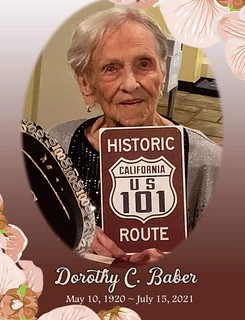 The answer to the first question should have been easy. Dorothy Baber died recently after living for 101 years and 66 days.
The answer to the first question should have been easy. Dorothy Baber died recently after living for 101 years and 66 days.
The second question was probably not so easy. The 2007 Coin World obituary for Betty Medlar mentioned that she was lead singer for the Buddy Brock Band, as did the 2008 obituary in The Numismatist.
Thanks, Pete. Interesting history. A special award for female members would seem oddly sexist today, but the 1970s and 80s were a different time. When were the last Spouse's convention medals issued, and the last Spouse's Luncheon held? -Editor
To read the earlier E-Sylum articles, see:
DOROTHY C. BABER (1920-2021)
(https://www.coinbooks.org/v24/esylum_v24n30a07.html)
RITTENHOUSE HALF DISMES REENACTMENT ANSWER
(https://www.coinbooks.org/v24/esylum_v24n38a14.html)
HARVEY STACK'S NUMISMATIC FAMILY, PART 105
The latest article in Harvey Stack's blog series covers a 1989 debate over the licensing of professional coin dealers. -Editor
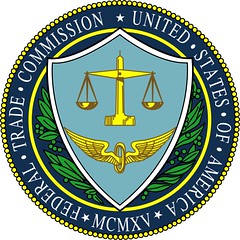 As noted earlier, in May 1989 I took part in a debate with the Federal Trade Commission (FTC) on the merits of their plan to require licensing of professional coin dealers. This debate was held at the Metropolitan New York Convention. Each side presented its case. Barry Cutler, the Director of the Federal Trade Commission (FTC) led off the discussions stating that U.S. coins were being counterfeited and sold as authentic and that there were Investment Funds that sold gold to clients at a low premium, stored them "free of charge," but did not ever deliver them to the buyer.
As noted earlier, in May 1989 I took part in a debate with the Federal Trade Commission (FTC) on the merits of their plan to require licensing of professional coin dealers. This debate was held at the Metropolitan New York Convention. Each side presented its case. Barry Cutler, the Director of the Federal Trade Commission (FTC) led off the discussions stating that U.S. coins were being counterfeited and sold as authentic and that there were Investment Funds that sold gold to clients at a low premium, stored them "free of charge," but did not ever deliver them to the buyer.
There were all kinds of scams, including instructing people to not open coin rolls or mint-sealed boxes or bags, as that would reduce the value. In this way customers could be ripped off by the inclusion of fake or low-grade coins that were only discovered if the roll or bag was opened. These were all concerns of the FTC, the Treasury Department/Secret Service, and the Security and Exchange Commission (SEC). From 1985 through 1989 the FTC apprehended some of these scam artists, arrested them, brought them to trial and fined them huge sums.
It was these offenses, along with misleading public advertising and various promotions that caused the FTC to seek a licensing requirement for all who bought and sold gold, treating coin dealers the same as they would proprietors of a pawn or hock shop. The FTC's Barry Cutler wanted to have this forum or debate to hear from the Professional Numismatists Guild, Luis Vigdor, and myself about how to start the procedure and what the possible damage was for a "basically good industry."
Luis Vigdor, who was a senior officer of Manfra, Tordella and Brooks (MTB), reviewed in detail the buying and selling of gold coins by his and most established companies. He confirmed that their staff could readily recognize the counterfeits and often shared their findings with the Secret Service. MTB also ran a daily "buy and sell" operation, as gold, like other precious metals had to be treated like other commodities, where the buy price is a small fraction below the sell price.
If a small coin dealer, a Mom and Pop operation, or a small local jeweler was treated like a pawn shop, they would have to verify the seller's identity, report the "buy" to the local authorities (as is required by a second-hand dealer's license in most cities and state) and would have to hold the coins for 30 days. Those who did not have enough capital could not afford to hold these items that long and could lose what they had invested. Since coins do not have a serial number or other special I.D., identifying stolen property would be virtually impossible. The suggested regulations could very well close many small coin shops, and have a detrimental effect, even on large coin dealerships. After Luis Vigdor's explanation about the running of a precious metal and rare coin business he turned the floor over to me.?
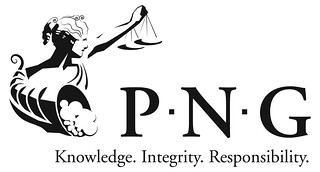 As president of the PNG, I was able to discuss the operation of the rare coin business. I started by explaining that most professional dealers have seen, bought and sold enough gold coins that they were readily able to recognize false or counterfeit pieces readily. The larger retail dealers across the country bought all types of coins, sold many over the counter or at public auction, and respected their clients. Their Code of Ethics required them to compensate anyone to whom they had sold a false coins. The PNG (the largest dealer organization in the United States), together with the International Association of Professional Numismatists (IAPN) provided guidance to rare coin professionals on such matters. As part of this debate, my role was to help the FTC understand that most professional coin dealers were not the problem, and that setting up a licensing system would not effectively address the situation.?
As president of the PNG, I was able to discuss the operation of the rare coin business. I started by explaining that most professional dealers have seen, bought and sold enough gold coins that they were readily able to recognize false or counterfeit pieces readily. The larger retail dealers across the country bought all types of coins, sold many over the counter or at public auction, and respected their clients. Their Code of Ethics required them to compensate anyone to whom they had sold a false coins. The PNG (the largest dealer organization in the United States), together with the International Association of Professional Numismatists (IAPN) provided guidance to rare coin professionals on such matters. As part of this debate, my role was to help the FTC understand that most professional coin dealers were not the problem, and that setting up a licensing system would not effectively address the situation.?
To read the complete article, see:
Harvey Stack Remembers: Growing up in a Numismatic Family, Part 105
(https://www.stacksbowers.com/News/Pages/Blogs.aspx?ArticleID=harvey-stack-remembers-105)
To read the earlier E-Sylum article, see:
HARVEY STACK'S NUMISMATIC FAMILY, PART 104
(https://www.coinbooks.org/v24/esylum_v24n37a20.html)
DAVISSON E-AUCTION 41 HIGHLIGHTS
The Davisson's E-Auction 41 closes this week. Here are some articles they published recently via client emails showcasing some sale highlights.
For more information, see:
https://davcoin.com/
.
-Editor
Ancient Coinage
Fall is upon us! Now is the time of year when we all wonder "where did summer go" and "how are we already halfway through September?"
The auction calendar is similarly inexorable–E-Auction 41 has just two weeks to go! Bidding closes on Wednesday, September 29th. This auction is particularly diverse, with significant sections devoted to World and U.S. in addition to our usual Ancient and British offerings. Below we look at a few notable lots in the Greek and Roman sections.
The Greek section of the sale is highlighted by several attractive large silver pieces–from the fine style nomos from Neapolis above, to the beautifully toned Calabrian didrachm below. We included many coins with a tie to wine—grape clusters and leaves, wine jugs, satyrs, and Dionysos. Look also for interesting bronzes and smaller silver pieces from Iberia and Sicily.
Alexander and related Macedonian issues are well represented by further selections from a mid-twentieth century North American collection we acquired recently. Collected in the 1950s and '60s, they are a fascinating snapshot of what was available to determined collectors at the time, even when located in the American Midwest and depending largely on bids and wantlists mailed to major London auction houses.
The East is represented by an interesting small group of Baktrian issues, along with a particularly attractive Indo-Skythian tetradrachm.
The Roman section packs a wide range into just 24 lots–a diverse handful of Republican silver and bronze, a thoroughly bankers' marked Mark Antony denarius, more selections from the mid-century North American collection mentioned above, and a diverse offering of provincial issues primarily from Thrace, to name a few.
There's more to see, take a look! We keep our E-Auctions small enough to browse easily, and diverse enough that there is a little something for everybody.
Stay tuned as we next turn to the British, World, and U.S. sections, each of which have some particularly interesting and attractive lots.
Scottish Coinage
E-Auction 41 closes next week! Bidding closes on Wednesday, September 29th. Read on as Allan introduces the first of four parts of a scholarly and comprehensive Scottish collection, which highlights the British section of this sale. (Look for more of the collection in our next two E-Auctions, and in our major annual auction early in 2022.)
The details of Scottish history are often evident in the coins of Scotland in ways that are not always so apparent in coins of many other countries. It is not just a question of the designs and the legends—naming the monarch and indicating the country by a coat of arms is not unusual. But the more you study Scottish coinage—particularly the hammered pieces—the more you see the Scottish spirit in the design and striking of the coins.
Scottish coinage begins showing a strong English influence. But the English at the time of the first Scottish coins were embroiled in a civil war, and the coinage was rough and irregular (phrases that pretty well describe Scotland at the time). By 1249 when the reign of Alexander III began, English coinage had gone through the refined short cross coinage that began under Henry II and was into the equally refined voided long cross issues of Henry III. It wasn't until Alexander's Second Coinage beginning around 1280 that the term refined
could be aptly applied to the Scottish coinage.
The parallels in design continued to be similar for Scottish silver coinage until the reign of James III and the groat issues (1471, 1484) that show a strong French influence with their realistic portraits. The circumstances leading to young Mary's betrothal and marriage to the young Francis who became Francis II was poignantly represented in the twelve penny groat with its Latin legend that translates They are no more twain but one flesh,
a verse from Matthew from the King James Bible. It was a love match but it was also an important political statement.
From this time on, Scottish coin design pretty much goes its own way. Mary's life is well chronicled in coins that reflect Continental tastes as well as her challenging life. Her son's reign went through eight different coinages before his ascending the English throne. From then on, Scottish and English coinage are variations on a similar theme.
British Tokens and World Coinage
E-Auction 41 closes next Wednesday, September 29th! Below Allan touches on highlights from the two substantial collections that make up our British trade token and World coinage sections.
A substantial part of our auctions for the past few months has been the presentation of two collections based on publications a century and more ago. The Michael Sussman Collection of British Trade Tokens follows the Dalton and Hamer reference completed in 1918. The major collection of world coins harks back to the 1860 publication by James Snowden of the official extensive U.S. Mint collection.
In this sale, tokens from the Mike Sussman Collection feature the extensive issue from Middlesex. Most of the Middlesex tokens listed here were issued for trade. John Lusk's 2014 book on tradesmen
tokens followed R. C. Bell's effort in his publication Commercial Coins 1781-1804 to take the multitude of forgeries, medalets, tickets, passes, specious and spurious pieces
out of the D&H universe and to reveal just the commercial coins for what they really are, a genuine coinage of necessity created by manufacturers and tradesmen to finance the Industrial Revolution.
Our presentation of this high quality collection will end soon—two more of our E-Auctions and some featured pieces in our major early winter 2022 auction will wrap it all up.
The collector who took Snowden's work as his goal picked an even more extensive challenge. Snowden's inventory included ancient coins (covered in under 60 pages), but the emphasis of the bulk of this 411 page reference was on Modern Coins.
Lief and I have been cataloging this collection since last year, and it has been fascinating. In the process the two of us have taken extra time to follow up on some of the historic byways that some of these coins represent.
It took Bolivia sixteen years of battle to free itself from Spain, and Simon Bolivar's role was so significant that the country was named after him. South America is represented in this catalog and the fluctuating fortunes of the continent are shown in its coinage.
The Empire of Brazil
lasted from 1882 to 1889 and had two emperors—Pedro I and his son Pedro II. It began with a war and ended with a coup.
Cundinamarca was a Colombian province and then a pre-Republican Republic that struck coins from 1814 to 1821. It became a part of the newly formed Gran Colombia in October of 1821, a Bolivar-led effort to federalize an area that now includes Venezuela, Ecuador, and Colombia. (All three of the coins in this lot are dated 1821, the end of the independent republic.)
Many of the other lots in this 16th to early 19th century cross section of coinage have tales to tell as well. Denmark's geography made it a key player in European history. This sale offers a Viking-era coin from Denmark (lot 56), and several lots tracing Danish history from the 16th to the 19th century. Several pieces represent the reign of Christian IV, the longest reigning Danish monarch, whose participation in the Thirty Year's War cost Denmark dearly. (His sister Anne was the wife of James VI of Scotland who became James I of England. European royal families frequently intermarried.)
The section of Danish issues continues down to the late 1800's, including the reign of Christian VIII who was also briefly Norway's king (as Christian Frederick). He was followed by Charles II (XIII of Sweden) and Charles III (XIV of Sweden).
Napoleon in Italy, British and Dutch colonial issues, Switzerland, Colonial America—we could say so much more about what all these coins represent. But the coins speak volumes for themselves.
For more information, see:
https://davcoin.com/
JOHN CROSS COLLECTION OF ANGLO-SAXON COINS
David Pickup passed along this article about the John Cross Collection of Anglo-Saxon Coins offered by the Canterbury Auction Galleries. Thanks. -Editor
When the executors began clearing the contents of a Canterbury pensioner's park home following his death last year, they discovered he had quietly amassed a sizeable collection of early Anglo-Saxon coins so valuable they were kept in a bank vault for safekeeping. When they were examined by the numismatic consultant at The Canterbury Auction Galleries, he described them as among the most important collection of Anglo-Saxon coins outside any UK museum.
The collection, which is expected to raise a total of around £75,000, will be dispersed in a sale on October 2-4, with the proceeds going to two charities according to his wishes.
On inspecting the gentleman's personal items, it appears he was very much into researching Anglo Saxon and Medieval history,
a spokesman for the executors said. He had a particular fascination for coinage from the period and he was also interested in early buildings and churches. He attended lectures and even held a certificate in archaeological excavation, for which he qualified back in 2010 when he was in his sixties
. He was born in 1949.
Records found in his park home showed he amassed his collection over a 20-30 year period, spending particularly freely between 2016 and 2017. It became so extensive and valuable that the coins were held in the bank for safe keeping. The proceeds from the sale will go to the The British Numismatic Society and Friends of Kent Churches, as he wished. The auctioneers, meanwhile, are producing a separate catalogue of the collection at their expense.
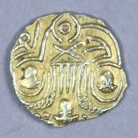 The single most valuable coin in the sale is an extremely rare gold Thrymsa, or shilling, dating from 640-660 and minted in Northumbria or York, which is estimated at £8,000-12,000, while a slightly earlier example, circa 635-645, showing the emperor with a diademed bust is estimated at £8,000-10,000.
The single most valuable coin in the sale is an extremely rare gold Thrymsa, or shilling, dating from 640-660 and minted in Northumbria or York, which is estimated at £8,000-12,000, while a slightly earlier example, circa 635-645, showing the emperor with a diademed bust is estimated at £8,000-10,000.
The collection is rich in coins with a connection to Canterbury. A silver penny with the head of an Archbishop and dating from 757-796 is estimated at £2,000-2,500, as is another circa 780, showing the head of the King of Kent. Cuthred, King of Kent, is recalled by a portrait silver penny dated from 798-807, the same estimate being given to another silver penny struck in 805-832, when Wulfred was Archbishop (each £1,800-2,000). Another, struck for Baldred, King of Kent dating from 823-825 is estimated at £1,000-1,500, as is another dating from 833-870, for Archbishop Ceolnoth.
Among many silver pennies in the collection, examples include one from 796-821 for Coenwulf (estimate £800-1,000) and 823-825 for Beornwulf (1,500-2,000); another dating from 840-852 for Beorhtwulf (1,200-1,500); 899-924 for Edward the Elder (£1,000-1.500); 924-939 for Athelstan (£2,000-3,000), while from 1066 – a date every pupil of English history knows – is a silver penny for King Harold II, killed at the Battle of Hastings. It is estimated at £1,500-2,000.
To read the complete article, see:
The John Cross Collection of Anglo-Saxon Coins
(https://www.thecanterburyauctiongalleries.com/news/the-john-cross-collection-of-anglo-saxon-coins/)
MORTON & EDEN OFFER SWEET TIN FIND
How many times have we heard the tale of rare coins found in an old tin can or box? Here's the latest in a press release from Morton & Eden. -Editor
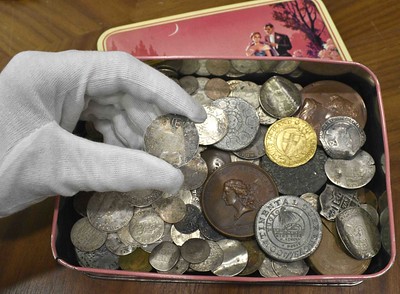 An extremely rare example of a mid 17th century New England shilling, one of the very first coins to have been struck in North America, has recently been discovered in an old sweet tin. It is due to be auctioned online on Friday 26 November by specialist auctioneers Morton & Eden in London, when it is estimated to fetch £60,000-80,000.
An extremely rare example of a mid 17th century New England shilling, one of the very first coins to have been struck in North America, has recently been discovered in an old sweet tin. It is due to be auctioned online on Friday 26 November by specialist auctioneers Morton & Eden in London, when it is estimated to fetch £60,000-80,000.
The coin was identified by coin specialist James Morton, who recounts; There were several hundred coins in the old Barker & Dobson sweet tin. The coins were completely varied, from all over the world and in all metals, ranging in date from medieval times right up to the 1970s. I could see straight away that there were plenty of interesting pieces alongside some ordinary modern coins, but there was one simple silver disc, which immediately jumped out at me. I could hardly believe my eyes when I realised that it was an excellent example of a New England shilling, struck by John Hull in 1652 for use as currency by early settlers in the Massachusetts Bay Colony.
The simple silver coin is of rudimentary and rustic design and bears the initials NE for New England, together with the Roman numerals XII (indicating 12 pence which equals one shilling). The New England shilling is one of only two or three dozen examples, which are known to survive.
James Morton added: Also in the tin was a Massachusetts ‘Pine Tree' shilling, the more sophisticated successor to the original New England issue, as well as two examples of ‘Continental Currency' pewter dollars bearing the date of the Declaration of Independence (1776), a ‘Libertas Americana' bronze medal, and several British hammered gold coins. But the star of the collection is undoubtedly the remarkable New England shilling, the plain appearance of which belies its historic significance''
The tinful of coins coin has been consigned to Morton & Eden for sale by the art advisor, the Hon. Wentworth Wenty
Beaumont, whose family seat is Bywell Hall in Northumberland's Tyne Valley. One of Wenty Beaumont's ancestors, William Wentworth (1616-97) is thought to have arrived in New England as early as 1636 and several members of the family were later to occupy prominent positions in the Colonies, including John Wentworth and his son (also John), both of whom represented New Hampshire in the Continental Congress of 1774-1781.
Wenty Beaumont recounts: My father recently found the tin in his study. If he knew it was there he had long since forgotten about it. I'd never seen it before and when I opened it I thought it was just a rather bizarre collection of random old coinage. However as I don't know anything about coins I felt it was worth checking out so I took it to show James Morton at Morton & Eden. I'm very pleased I did and needless to say I was completely amazed when James Morton pointed out how important the rare shilling was in the context of North American history. I can only assume that the shilling was brought back from America years ago by one of my forebears.
The early North American shilling will be auctioned online by Morton & Eden on 26 November together with other coins from the 1960s sweet tin.
For more information, see:
https://www.mortonandeden.com/
THE BOOK BAZARRE
NUMISMATIC NUGGETS: SEPTEMBER 26, 2021
Here's a selection of interesting or unusual items I came across in the marketplace this week. Tell us what you think of some of these. -Editor
The half dollar proved to be an acceptable alternative to silver dollars. Researchers have differing opinions about exactly how many 1794 half dollars were struck, but the prevailing consensus (based on Mint delivery warrants) suggests 5,300 1794 half dollars were delivered in December 1794 and 18,464 half dollars dated 1794 were delivered on February 4, 1795 for a total of 23,464 pieces struck. A survival rate between 3% and 4% -- typical for early Mint issues -- further supports the estimated mintage. Approximately 800 1794 half dollars are thought to survive, including all grades and varieties.
Flowing Hair half dollars circulated extensively. They were a "blue collar" coin -- less spectacular than the silver dollars, but often the preferred denomination in commerce. For today's collectors, 1794 half dollars offer a relatively affordable alternative to the rare and expensive 1794 dollars, although no one would turn down an opportunity to have both. In relation to their mintage, 1794 half dollars are far rarer in high grades than their dollar counterparts, and they are equally rare in terms of the sheer number of high-grade survivors (AU and finer). Uncirculated 1794 half dollars are great rarities, with just 9 Mint State pieces reported by PCGS and NGC combined.
A nice coin from the Heritage October Long Beach sale. -Editor
To read the complete lot description, see:
1794 50C O-105, T-3, High R.4, AU58+ PCGS....
(https://coins.ha.com/itm/early-half-dollars/half-dollars/1794-50c-o-105-t-3-high-r4-au58-pcgs-pcgs-39206-/a/1334-3507.s)
Civil War token Fuld MA115E-2a R6 NGC MS66 RB 20% Red with great cartwheel luster. Jos. H. Merriam Medalist, Die Sinker And Letter Cutter Established 1850 No. 18 Brattle Square, Boston Jos. H. Merriam, Boston 1863 Not One Cent. We sold this very token on eBay in October 2018 where it realized $785.
A beautiful Merriam die sinker storecard offered by Steve Hayden. -Editor
To read the complete item description, see:
MA115E-2a Boston Massachusetts Civil War Token NGC MS66 RB Merriam Die Sinker
(https://www.civilwartokens.com/Listing/Details/3174341/MA115E2a-Boston-Massachusetts-Civil-War-Token-NGC-MS66-RB-Merriam-Die-Sinker)
PRISON TOKEN GRASS LAKE MICHIGAN GOOD FOR
An interesting-looking prison token with an unusual blue color. -Editor
To read the complete lot description, see:
PRISON TOKEN GRASS LAKE MICHIGAN GOOD FOR
(https://auctions.bidalotcoinauction.com/lots/view/1-51D8UK/prison-token-grass-lake-michigan-good-for)
An online search found some additional information. -Editor
Camp Cusino was created in 1951. It is located one mile west of Shingleton, Michigan. The camp was officially called the Cusino Corrections Prison Work Camp and was part of the Corrections Conservation Prison Camp Program in the State of Michigan. The name Cusino was taken from a Civilian Conservation Corps (CCC) camp that was located four miles east of Melstrand, Michigan. In 1951, some of the CCC buildings were moved to Shingleton for the prison camp. The inmates were trustee status and many worked for the neighboring Cusino Wildlife Research Station. Other inmates were transported daily to do timber stand improvement and maintain area state parks.
To read the complete articles, see:
30 PRISON INMATE TOKENS GRASS LAKE MICHIGAN WORK CAMP CUSINO PENITENTIARY JAIL
(https://www.worthpoint.com/worthopedia/30-prison-inmate-tokens-grass-lake-417908374)
Camp Cusino
(https://en.wikipedia.org/wiki/Camp_Cusino)
The highest award in Canadian numismatics. Awarded to Dr. Harold Don Allen in 2003. It weighs .75 troy ounces and is 1.5 inches in diameter. After 1989, the medal was gold plated on sterling silver. The medal was designed by Arnaldo Marchetti and originally produced by the Lombardo Company in Quebec. It is now produced by the Royal Canadian Mint. The obverse features a bust of the famous Canadian numismatist J. Douglas Ferguson with the inscription J. Douglas Ferguson Award: the reverse shows allegorical figures representing hard work, prosperity, victory science or knowledge. A rare opportunity to acquire a Canadian icon specimen. Accompanied with J. Douglas Ferguson Award Certificate, and banquet program.
A beautiful medal. From the upcoming Geoffrey Bell Toronto Coin Expo Sale. -Editor
To read the complete lot description, see:
H. Don Allen Collection - Ferguson Medal
(http://auctions.gbellauctions.com/H-Don-Allen-Collection-Ferguson-Medal_i43022529)
(t) CHINA--EMPIRE. Ta Ching Government Bank. 5 Dollars, 1909. P-A77s. Specimen. PMG Superb Gem Uncirculated 67 EPQ.
(S/M#T10-31). Printed by ABNC. Specimen overprint, serial numbers and punch cancels. Portrait vignette of Li Hung Chang at left along with a gazebo at right with large central multicolored guilloche between. Ornate blue under-printed design covers the face with location protectors at far left and right. Brown inks make up the lathe frame. Original paper throughout with vivid ink and a lovely Gem appeal. PMG has graded 16 notes for this pick variety, with this note being tied for the finest encapsulated by their service with just a single note. PMG Pop 2/None Finer.
A colorful American Bank Note Company product in the upcoming Stack's Nowers September 2021 Hong Kong Auction. -Editor
To read the complete lot description, see:
(t) CHINA--EMPIRE. Ta Ching Government Bank. 5 Dollars, 1909. P-A77s. Specimen.
(https://auctions.stacksbowers.com/lots/view/3-SX2PG/t-china-empire-ta-ching-government-bank-5-dollars-1909-p-a77s-specimen-pmg-superb-gem-uncirculated-67-epq)
c1750 Philadelphia Colonial Paper Money Broadside
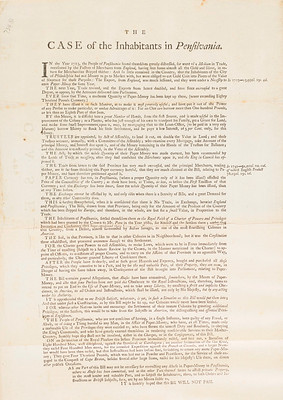 EARLY AMERICAN FINANCE – Broadside. The Case of the Inhabitants in Pensilvania. [Philadelphia? c. 1750].
EARLY AMERICAN FINANCE – Broadside. The Case of the Inhabitants in Pensilvania. [Philadelphia? c. 1750].
Pennsylvania resists London's moves against colonial-issued paper money. A rare and unusual broadside that discusses an anti-paper money bill then pending in Parliament. The anonymous author takes pains to demonstrate that while some colonies (especially those in New England) followed practices that led to the devaluation of their currencies, Pennsylvania had been prudent in limiting the amount in circulation and exhorting in closing: "IT is humbly hoped that this Bill WILL NOT PASS." Bristol B1170, Shipton & Money 40217 with both assigning a date of 1742. This date is likely based on the mention of the siege of Cartagena (1741) in the text. However the text references additionally the capture of Cape Breton Island which would suggest this broadside was produced sometime after 1745.
Printed broadside, 418 x 265mm (partial split at lower horizontal crease, slight loss along left margin infilled with laid paper, light foxing) tipped along lower margin into a half-calf quarto folder.
Please note this lot is the property of a private individual.
For bibliophiles, researchers and colonial paper money mavens is this c1750 Philadelphia broadside discussing an anti-paper money bill then pending in Parliament. From the Christie's October Online Auction 19988. -Editor
To read the complete lot description, see:
Defending colonial paper money
Anonymous, c. 1750
(https://onlineonly.christies.com//s/fine-printed-books-manuscripts-including-americana/defending-colonial-paper-money-177/129968)
A partly printed check drawn on the Office of Discount & Deposit in Washington, filled in and signed by Van Buren May 26, 1826 to pay Mr. Cambersling $107.60. Very good condition, the usual cancellation cuts not affecting the signature. Printed checks of Van Buren are inexplicably rare on the market. Only a handful have ever been sold; simple handwritten payment orders are the norm for him.
Something to financial history, check and autograph collectors. Unfortunately the item is not fully imaged. -Editor
To read the complete item description, see:
Scarce Printed Bank Check Signed by President Martin Van Buren in 1826
(https://www.abebooks.com/servlet/BookDetailsPL?bi=31009559650)
WAYNE'S NUMISMATIC DIARY: SEPTEMBER 26, 2021
Tuesday September 21, 2021 was the night of my Northern Virginia numismatic social group, Nummis Nova. Wayne Herndon was our host at the French restaurant Mon Ami Gabi in Reston Town Center. Chris Neuzil was already seated at our table when I arrived. We were soon joined by Jon Radel, Roger Burdette, Wayne himself and finally Julian Leidman. It was a small turnout, but made for a great discussion forum.
As a social group our discussions are not just numismatic, and we learned about family members, Chris' fender-bender, multiple facts and opinions about the ongoing pandemic, and Roger's dreams. Roger described a dream that could be classified in the modern category of "electric vehicle range anxiety", wherein he kept being frustrated in attempts to recharge and get to his final destination. He explained that he often writes down dreams to provide his acting-student daughter ideas for skits and plays. When someone questioned the usability of the premise, I said, "You could name it 'Waiting for Rogot'..."
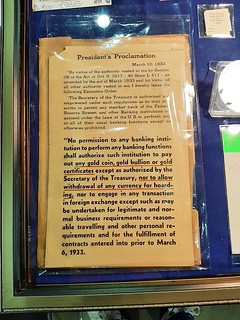 With the smaller turnout numismatic displays were short in supply, but I passed around my recent acquisition from Fred Weinberg, a 1933 poster for banks about the implementation of the March 10 Presidential Proclamation on gold coinage. I'd seen it in his case at the ANA, and he kindly sent it to me for an offer. I'm happy to now have it as part of my numismatic ephemera collection.
With the smaller turnout numismatic displays were short in supply, but I passed around my recent acquisition from Fred Weinberg, a 1933 poster for banks about the implementation of the March 10 Presidential Proclamation on gold coinage. I'd seen it in his case at the ANA, and he kindly sent it to me for an offer. I'm happy to now have it as part of my numismatic ephemera collection.
I also brought with me the Where's George dollar I described last week. Jon looked it up online and reported its presence in Reston. At the end of the evening I spent it with a cash tip. It will be interesting to see whether and when it's reported again.
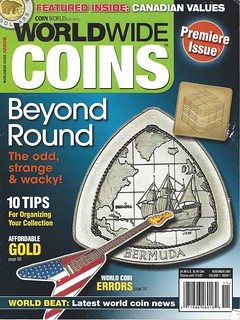 A few weeks back our old Nummis Nova regular Howard Daniel (now retired and moved to Florida) stopped by my house with some donation material. Included were copies of the November 2007 Premier Issue of Worldwide Coins magazine from Amos Press and Coin World. He'd had a table at a show next to Amos Press and picked up a box of copies the staff left behind. The publication apparently didn't take off, but was nicely produced. Can any of our readers tell us more about it?
A few weeks back our old Nummis Nova regular Howard Daniel (now retired and moved to Florida) stopped by my house with some donation material. Included were copies of the November 2007 Premier Issue of Worldwide Coins magazine from Amos Press and Coin World. He'd had a table at a show next to Amos Press and picked up a box of copies the staff left behind. The publication apparently didn't take off, but was nicely produced. Can any of our readers tell us more about it?
Other topics centered on the American Numismatic Association and its role and relevance in the hobby and the world at large. When the topic of battling counterfeits online came up, I noted that well, outside groups ACEF, NGC and PCGS "just sent a sternly worded letter to Mark Zuckerberg." There was discussion of the ANA's earlier creation and later sale of the ANA Certification Service (ANACS), and whether the organization was abdicating responsibility for a key need, and the impression that "the ANA hasn't done anything serious about counterfeiting since the Hobby Protection Act nearly fifty years ago."
It was another great evening of numismatic discussion and fellowship. I'm looking forward to next time.
To read the earlier E-Sylum articles, see:
WAYNE'S AUGUST 2021 ANA DIARY, PART TWO
(https://www.coinbooks.org/v24/esylum_v24n34a21.html)
WAYNE'S NUMISMATIC DIARY: SEPTEMBER 19, 2021
(https://www.coinbooks.org/v24/esylum_v24n38a17.html)
ROMAN GOLD COIN FIND NEAR SPAIN
Arthur Shippee and Peter Huntoon passed along this article about a find of Roman gold coins near Spain. Thanks. -Editor
Freedivers off the coast of Spain have uncovered a treasure trove of 53 perfectly preserved gold coins from the Roman Empire, one of the largest collections ever found in Europe.
Brothers-in-law Luis Lens and César Gimeno were freediving in the Mediterranean Sea while on vacation in Xàbia, Spain. Cleaning up trash, according to The Times, as they explored the underwater scenery they came across a shiny object that resembled a "10-cent-coin," newspaper El Pais said.
After retrieving the object, they noticed an inscription with an ancient Greek or Roman face and assumed it was from jewelry.
Using the corkscrew of a Swiss Army knife, they discovered another seven coins embedded in a rock crevice.
After reporting their discovery to local authorities, a team of scuba divers and archaeologists uncovered a total of 53 gold coins, three nails, and some remains of what appeared to be a chest.
Scientists from the University Institute for Research in Archeology and Historical Heritage analyzed the coins. They found they were from the end of the 4th century and the beginning of the 5th century.
"It's incredible. It's every child's dream to find a treasure," Luis Lens told El Pais.
Researchers were able to identify the emperors on the coins: Valentinian I (3 coins), Valentinian II (7 coins), Todosio I (15 coins), Arcadi (17 coins), Honorius (10 coins), and an unidentified coin.
Historians said that the coins could have been intentionally hidden to avoid looting barbarians, such as the Alans.
The coins will be restored and exhibited in the Soler Blasco Archaeological and Ethnographic Museum of Xàbia, the University of Alicante said.
To read the complete article, see:
Amateur divers find an 'incredible' treasure trove of gold coins from the Roman Empire while cleaning up trash on the seabed
(https://www.businessinsider.com/spain-roman-gold-coins-found-by-amateur-divers-clearing-trash-2021-9)
ROOSEVELT AND HARDING INAUGURAL MEDALS
Stack's Bowers' Director of Consignments and Numismatics James McCartney published a blog article about two rare inaugural medals coming up for sale in the firm's November 2021 Whitman Coin Expo sale. -Editor
Stack's Bowers Galleries is thrilled to present some of the most famous and elusive United States Inaugural bronze medals in our official auction for the Whitman Coin & Collectibles Winter Expo in November. Highlighted by an incredible Gem SP-65 (PCGS) 1905 Roosevelt medal and an Uncirculated SP-62 (PCGS) 1921 Harding medal, this will be one of the most important offerings from this series in recent years.
The 1905 Roosevelt Inaugural medal is among the most prized United States medals, not only for its subject matter and rarity, but just as much for the artist who designed it, the firm that cast it, and its influence on American coinage. It was this medal that inspired Theodore Roosevelt to approach Augustus Saint-Gaudens to create more sculptural and classical designs for United States coinage. The medal directly influenced the design of the reverse of the Indian ten-dollar gold eagle introduced in 1907, also by Saint-Gaudens. The relationship between the president and the artist has been well documented and led to the creation of Saint-Gaudens' beautiful and popular double eagle and eagle designs.
Today, Saint-Gaudens' Roosevelt Inaugural medal ranked number 27 in the popular 100 Greatest American Medals and Tokens (2007). Just 150 examples of this medal were authorized to be produced by Tiffany in bronze and each survivor is a treasure.
Graded SP-65 (PCGS), the beautiful example in our November sale is exceptionally well preserved with handsome deep brown patina and intermingled sandy-gold highlights on both sides. The striking detail is bold for the type, and closer inspection reveals fine granularity to the finish, also typical. The overall appearance is very smooth, as befits the assigned Gem grade.
While not as famous as the 1905 Roosevelt Inaugural medal, the medals of Warren G. Harding's 1921 inauguration are exponentially rare and each appearance is a significant numismatic event. Fewer than 60 are thought to survive in bronze, most of which are held tightly in private collections. We have not handled a bronze example since our March 2011 Baltimore sale, where it brought $17,250. More recently a silver example realized $31,200 in our November 2019 Baltimore auction. The present bronze striking, graded SP-62 by PCGS, is sure to sell for a strong price. It is gorgeous with glossy surfaces and original patina throughout. Dominant golden-brown color gives ways to faded mint rose around and within Harding's portrait, as well as vivid cobalt blue undertones, especially on the obverse. The strike is impressively sharp and perfectly centered.
These two rarities will be offered alongside an impressive selection of Inaugural medals and Indian Peace medals in the Stack's Bowers Galleries November 2021 Showcase Auction.
To read the complete article, see:
Rare Roosevelt and Harding Inaugural Bronze Medals Featured in our November 2021 Showcase Auction
(https://www.stacksbowers.com/News/Pages/Blogs.aspx?ArticleID=theodore-roosevelt-and-warren-harding-medals-stacks-bowers-galleries)
I like how the Harding portrait is placed on the obverse. It's unusual for a portrait to not be centered, and the placement is very effective in this case, making good use of the space. A powerful portrait.
Don't forget Matthew Chiarello's book on inaugural medals that we discussed recently. -Editor
To read the earlier E-Sylum article, see:
NEW BOOK: OFFICIAL INAUGURAL MEDALS, 2ND ED.
(https://www.coinbooks.org/v24/esylum_v24n36a03.html)
$10 DESERET CURRENCY PLATE OFFERED
In February we discussed the discovery of an engraving plate for a previously unknown $10 Deseret Currency Association note. The plate is being offered by Heritage Auctions in their October 2021 Long Beach sale. What a great centerpiece for a collection of Mormon currency! -Editor
Salt Lake City, UT- Deseret Currency Association Copper Printing Plate for Unknown $10 Denomination 18__ "As Made" condition. We are honored to be offering a ground breaking and historic piece of numismatic and Mormon history this evening. The item being offered is the original copper printing plate which was intended to be used to print a $10 denomination as part of the Deseret Currency Association (DCA) issue. The DCA was formed in January 1858 to provide currency for use in commerce in an area that was almost totally without other types of currency. Prior to the issue of the DCA notes, all that was available was a minimal amount of U.S. coins, an equally small issue of Mormon gold coins, and a few reissued earlier Mormon bank notes.
Early DCA notes were simple, hastily printed designs and comprised denominations including $1, $2, $3, $5, $10, $20, $50 and $100. Nearly $67,000 of these first series notes were printed by the spring of 1858 in Salt Lake City and Fillmore. According to noted expert Douglas Nyholm, only $1s and $2s along with a single $3 are known from this first series at present.
Mere months after the first series, engraved copper plates, whose note designs were created by Henry Maiben and engraved by David McKenzie, were used to print a second and more elaborate set of four denominations: $1, $2, $3, and $5. Surviving notes of all four denominations are known, although all are very rare. Nyholm reports that by late Summer of 1858, engraved second series notes were being printed at the Deseret News office in Salt Lake City. Engraved notes, with a face value of just over $28,000, were printed. A large percentage of the notes of both series were ultimately redeemed and destroyed. Thus ends the common wisdom on this subject which was turned upside down with the discovery of a printing plate designed to print a $10 note as part of the second series.
The Plate The $10 plate fits well into the parameters of the second series engraved notes. The text promises that the notes are payable in livestock and Brigham Young's signature is engraved and of the same style as on other denominations. The portraits of two prominent men associated with the Church appear on the $10. According to Nyholm, those appearing on the newly discovered $10 plate are Parley Pratt on the left and Willard Richards on the right. Pratt was an early leader of the Latter Day Saint Movement whose writings were widely read and served as an exposition on the Latter Day Saint faith. Pratt died in 1857. Willard Richards was a physician and Second Counselor to Church President Brigham Young from 1847 until his death in 1854. Interestingly, the portrait of Richards does not appear to have been completely engraved when work on this plate ceased. There is a good deal of background information available to help explain why the $10 plate was never completely finished and apparently never used.
Pieces like this are difficult to value. Obviously the plate is unique, but it also has important historical and numismatic significance. We believe that our estimate for this wonderful item is both conservative and reflective of the plate's significance
To read the complete lot description, see:
Deseret Currency Association $10 Copper Printing Plate
(https://currency.ha.com/itm/obsoletes-by-state/utah/salt-lake-city-ut-deseret-currency-association-copper-printing-plate-for-unknown-10-denomination-18-as-made-/a/3585-21206.s)
To read the earlier E-Sylum article, see:
$10 DESERET CURRENCY PLATE DISCOVERED
(https://www.coinbooks.org/v24/esylum_v24n06a13.html)

